This story is about my first time climbing in the Alps — in the Dachstein mountain range — in August of 2025, during a course with the DAV Summit Club. For me it was an unforgettable experience, that shaped me deeply.
This year has been full of firsts for me 🥰 (the reasons deserve their own stories) — a year in which I changed more than ever before. In particular I’ve started sports climbing and bouldering for the first time of my life — even a year ago that would have seemed unthinkable to me 🤣. On that occasion, one of my personal highlights this year has been my first via ferrata — also my first time climbing in alpine terrain – and for me personally one of the best vacations of my life so far 🥰. A tour where I’ve learned a lot and in many ways an adventure where I truly felt at home.
The following tale ended up a lot longer than anticipated, but I enjoyed writing it greatly and I wish you a great reading experience 🤗.
My path to the mountains
My passion for spending time in the mountains — especially hiking — began just a little over two years ago, when I moved to Braunschweig. The Harz highlands, home to Northern Germany’s highest peak, the Brocken, are only a short drive away. Once I finally found hiking boots that actually fit 😁, I started exploring the area — and quickly discovered both joy and challenge there 🤣 (a story in its own right).
That same year, I went to the Swiss Alps and decided to do a multi-day hike. Being underprepared and overexerted, I eventually decided to stop, change my plans, and give myself time to train and learn more — yet I still enjoyed that tour immensely.
Last year, I joined a guided group to hike across the Alps — learning a lot, becoming a better hiker, and enjoying it thoroughly, though I also felt slightly underwhelmed, as it didn’t feel as challenging as I had hoped.
Still, I felt unprepared for more demanding routes, especially those involving climbing sections. So this year, I decided to take it a step further and learn rock climbing — taking several indoor and outdoor courses.
To build on that, I joined a one-week alpine climbing course in August 2025 at the Dachstein mountain range in Austria, organized by the DAV Summit Club. That course became part of a three-week journey (I’ll definitely write more about some parts of it in a future article 😉) — and it turned out to be an unforgettable experience 🥰.
Off to a rainy start
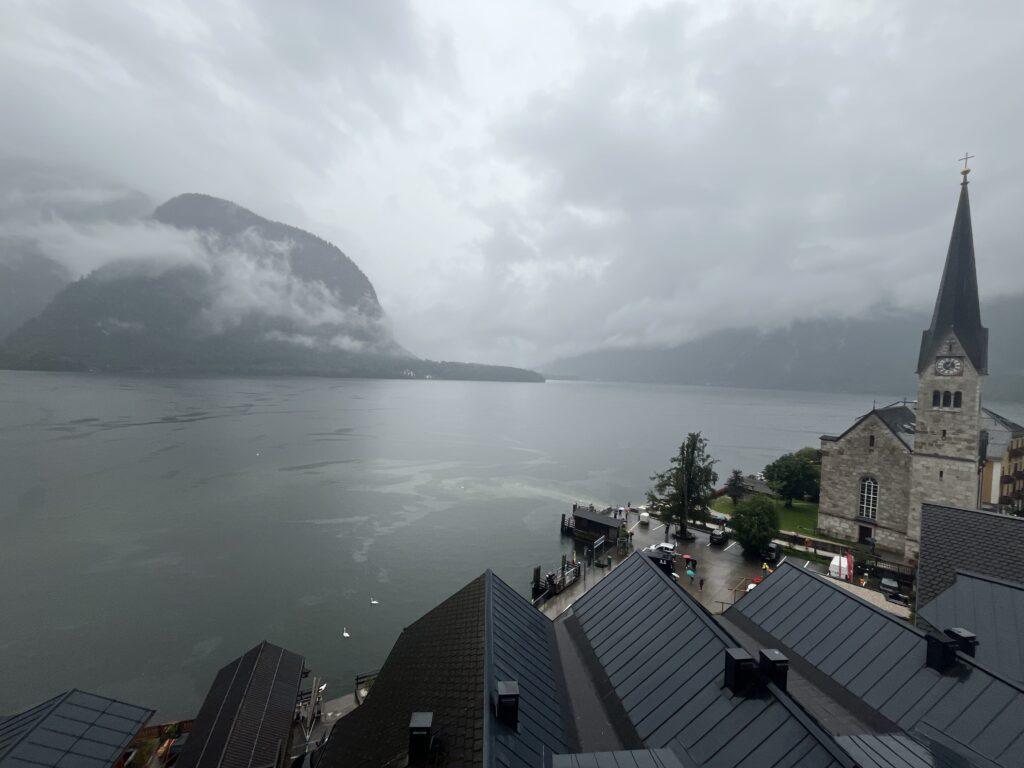
Before the course began, I decided to do a bit of sightseeing around Lake Hallstatt — visiting Hallstatt itself in classic rainy weather, exploring the Dachstein Mammoth Cave 😮 and the Dachstein Giant Ice Cave, and even meeting one of the other participants before the course had officially started 😊. We enjoyed a relaxed dinner together that evening.
The next day, I met another fellow member of our group, who kindly offered us a lift to the cable car station — and even a spot in her car to store some of my stuff for the next stage of my journey 😊.
There, we met the remaining two participants as well as our mountain guide and coach for the week. From there, we took three cable cars up along the Dachstein-Krippenstein-Seilbahn from Obertraun to the Gjaidalm.
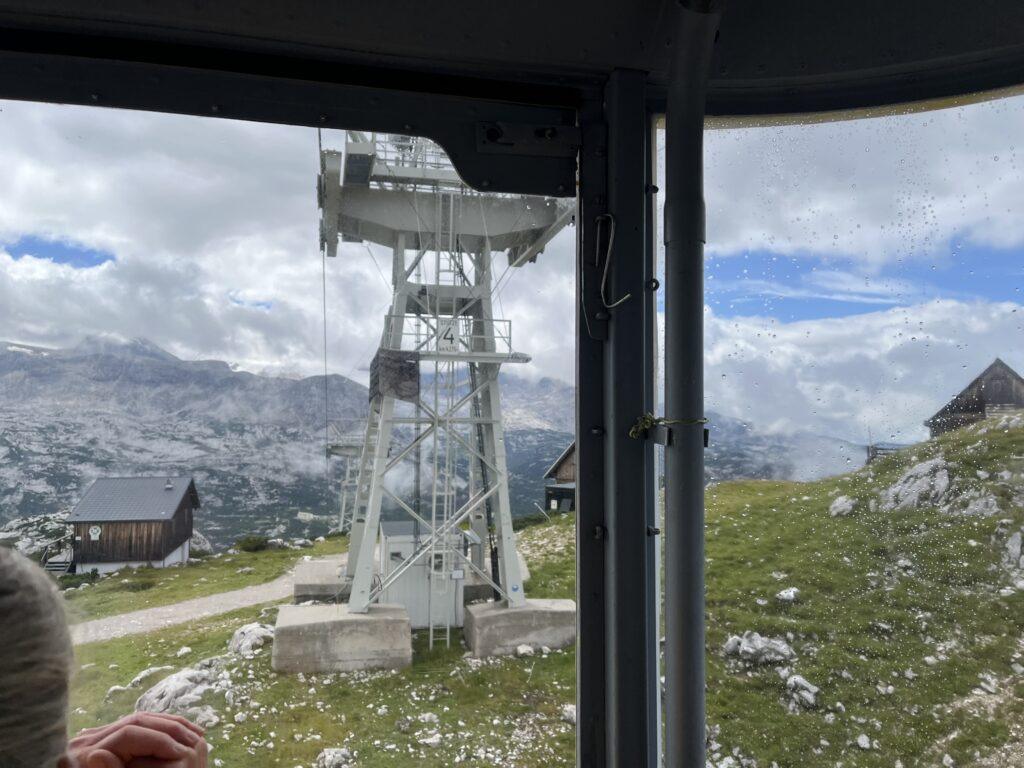
At the Gjaidalm, we started our hike to what would be our home for the next week — the Simonyhütte, a mountain hut operated by the ÖAV. The trail greeted us at first with sunshine and vibrant green vegetation — plants that I would later start missing, as these were rare sight higher up — and later with occasional rain showers. Luckily, I had my umbrella ready 😉 (a lesson I learnt during my hike across the Alps).
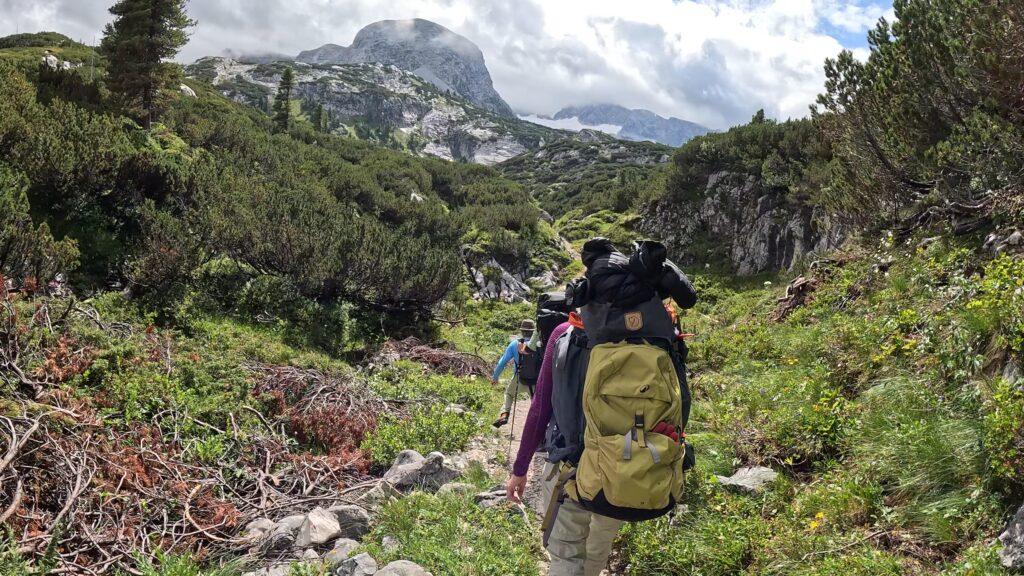
The hike to the Simonyhütte took about three hours, including several breaks. The final ascent was marked by a series of switchbacks — and, as our guide joked, whoever counts them correctly will have their sins forgiven. Sadly, I kept all of mine 🤣. Along the way, we passed the first “hut” built in the Dachstein area — the Hotel Simony, originally constructed in 1843.
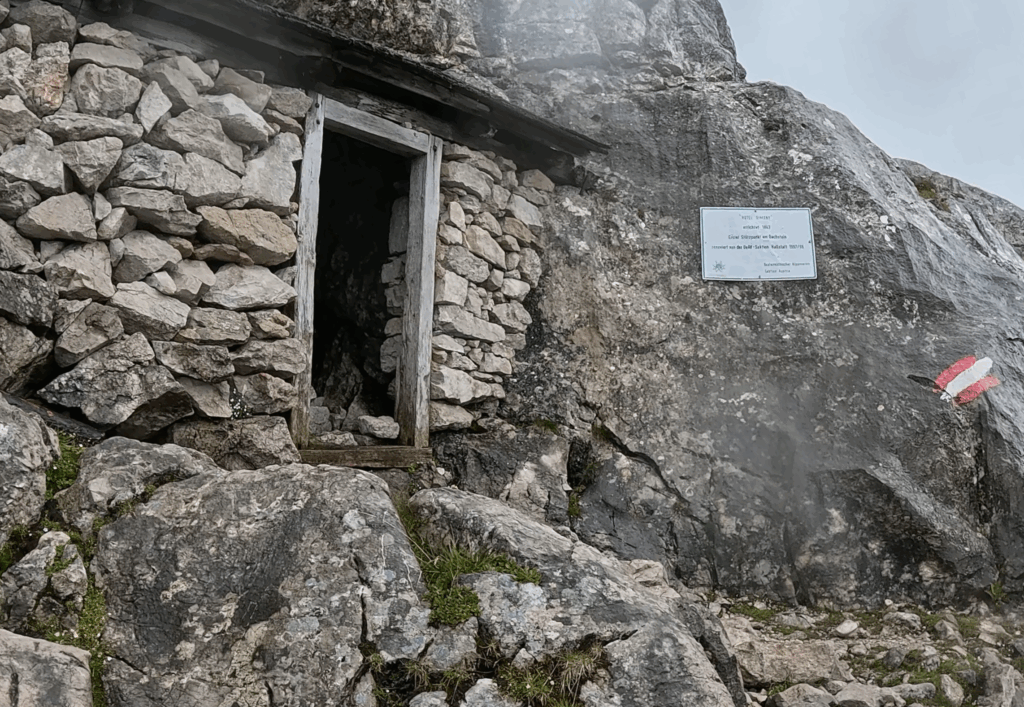
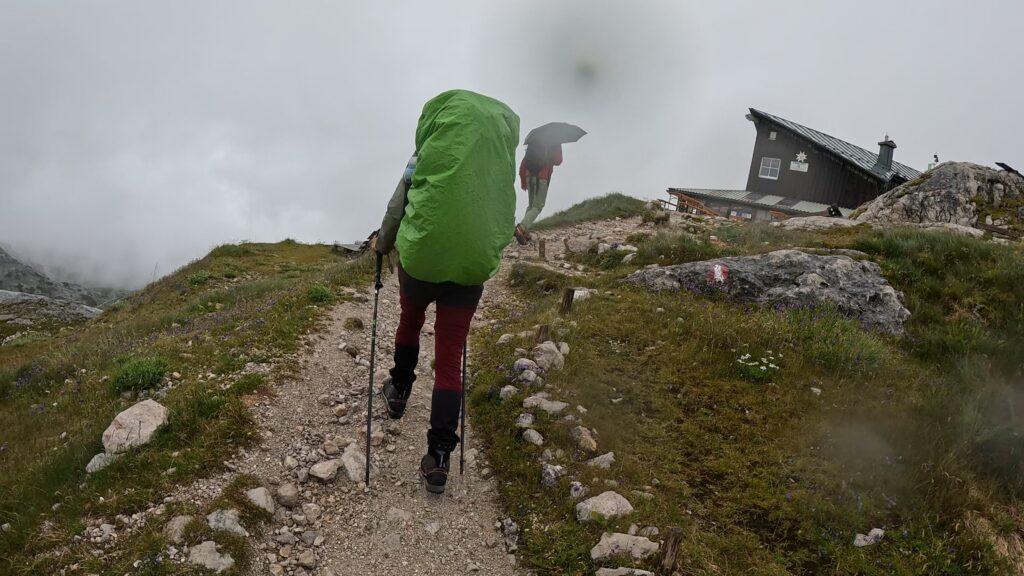
A few minutes later, we finally reached our destination and home for the coming days — the Simonyhütte at around 2,205 m. Upon arrival, we handed in our hiking poles to get used to walking without them. Afterwards, we settled into our cozy, spacious dormitory, where everyone somehow managed to have a bed — or even two — to themselves 🥳.
Dinner was delicious — a soup, with the choice of a vegetarian 😊 or non-vegetarian main dish (ok for me only vegetarian 😅), and dessert, with refills available 😁. It was also a great opportunity to get to know each other and to talk about our reasons for joining the course. I’d already learned a lot by then — small but useful things, like bringing a thermos, fresh ginger, and a knife to prepare it 🤩, as well as a few fun games to pass the time together 😉.
I also picked up some new inspiration to finally take the plunge into cold-water swimming 🫠 (though at that time, I was still a terrible swimmer 😅). We also discussed the schedule for the week ahead — but, thanks to the much better weather than expected 😊, we ended up not sticking to that plan entirely.
Learning to walk
The first night wasn’t great — my body still had to adjust to the altitude, and I didn’t sleep much 🤷♀️. But breakfast was definitely uplifting 😊.

The day began under a blanket of clouds, with the Hallstätter glacier still mostly hidden and the Schöberl standing out as the prominent landmark 😀 — the first mountain I’d end up climbing twice. Our first goal before lunch was to learn how to walk safely in difficult terrain, making sure we were all sure-footed:
- going up and down steeper slopes (up to around 30°)
- going sideways on steeper slopes
- getting used to and trusting the grip of our hiking boots
- using hands and feet to move safely on steep ground
- practicing how to stop yourself on all fours when slipping
- jumping between rocks and adjusting direction dynamically
- learning about the peculiarities of the Dachstein terrain — especially dolines
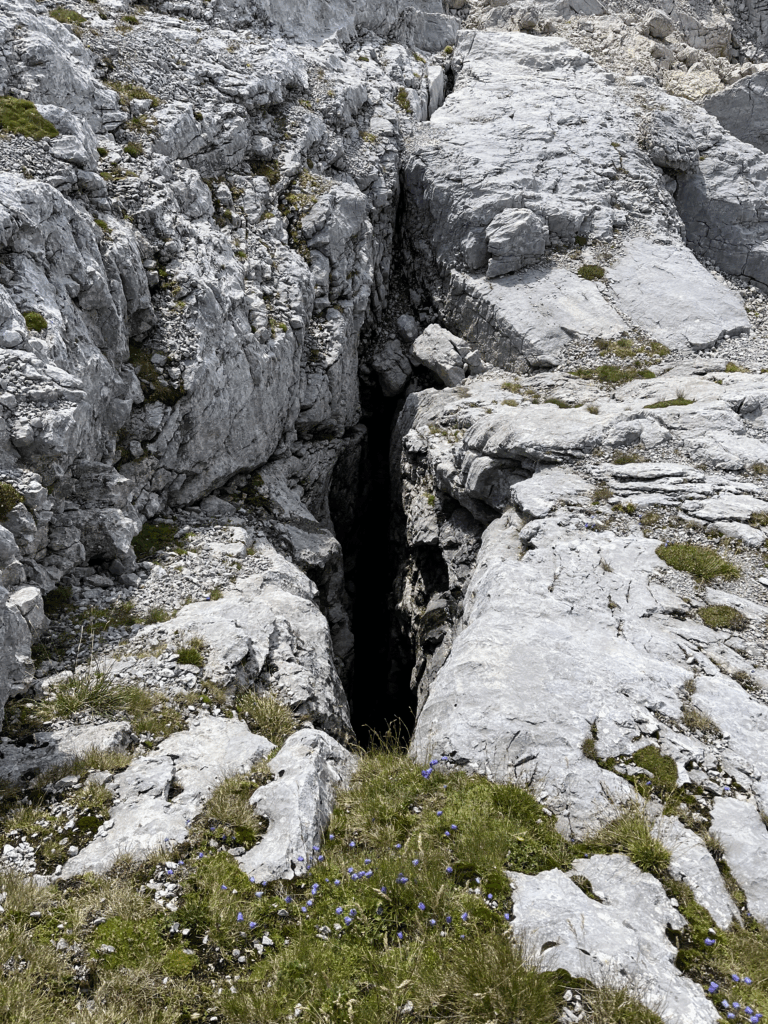
Dolines
The Dachstein mountains primarily consist of limestone, which dissolves under rain and meltwater. Over time, this creates sinkholes known as dolines — often dangerous, and occasionally fatal. In winter, they may be covered by snow, turning into hidden traps.
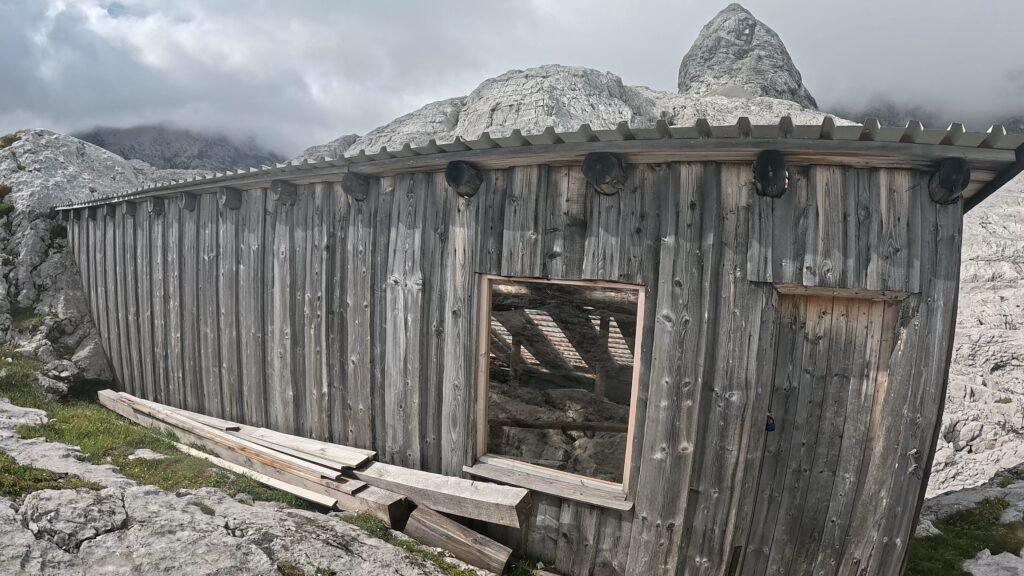
While hiking, we passed a hut that contained a doline used for climbing and training during bad weather — a place we would later explore from the inside.
During our lunch break, I had my first Kaspressknödel soup — and loved the roasted aroma of the dumpling 😋. After lunch, we received some of our equipment for the week: a helmet, via ferrata set, cords, webbing slings, carabiners, a climbing harness, an abseil device, and ropes. We then learned several basic knots — the Prusik, the double figure-eight, and the Munter hitch (German: Halbmastwurf) — as well as how to properly carry our gear, especially the cords and slings.
Later in the afternoon, we went to a short training via ferrata — technically my first via ferrata. At first, I was unsure if I could manage the proper moves 😅🤣. I still felt a bit unprepared and especially insecure about finding proper footing on the way down. In the end, it turned into a great exercise — even though I didn’t always feel fully confident. That’s something I still want to work on. But despite my focus on the activity itself, I enjoyed it — and learned a valuable lesson from someone else: sometimes, you just need to take a moment, enjoy the view, and stop worrying so much 😁.
The day ended with another great dinner and some fun games 😁 — a card game whose name I’ve sadly forgotten, and Bananagrams (building words from connected letter tiles).
My first summit cross
The second night, I slept much better and enjoyed breakfast even more 😊.
Our plan for the day was two-fold: first, to climb the via ferrata to the top of the Schöberl in the morning, and then to do some rope climbing in the afternoon. The weather had improved a lot — it was bright and sunny with some clouds remaining.
Climbing the Schöberl
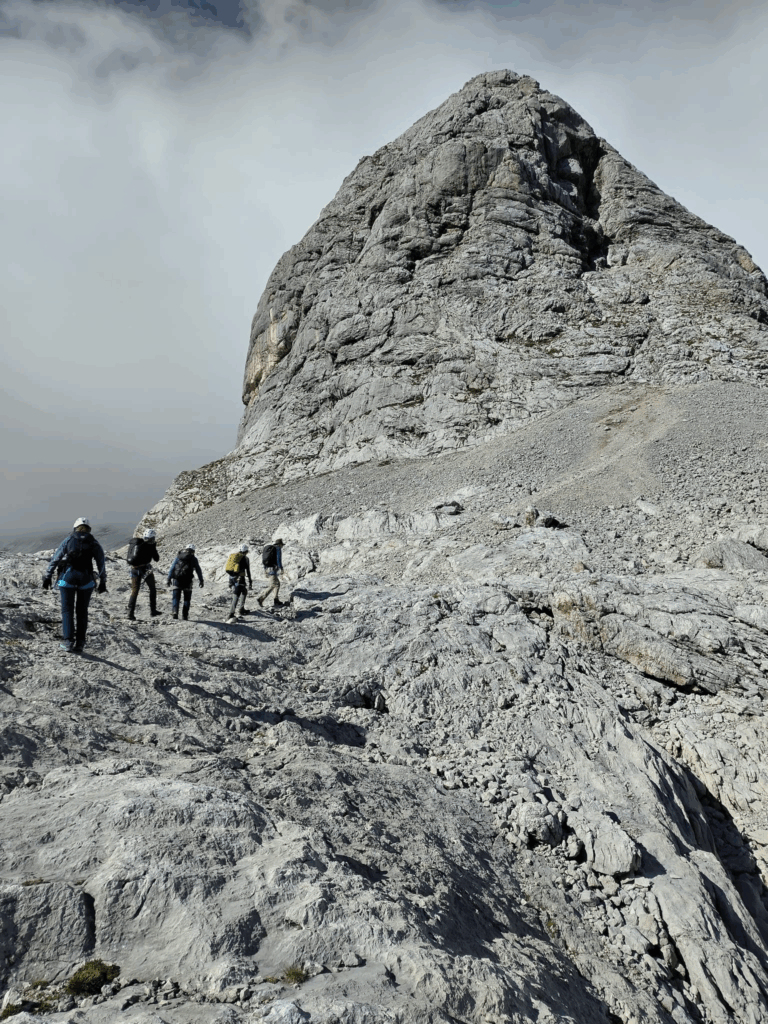
The Schöberl rises to about 2,426 m and is less than a kilometer from the Simonyhütte. We planned to climb it via the Moni-Klettersteig, named after the wife of a former Simonyhütte innkeeper. It’s a B/C via ferrata in the Austrian classification — not difficult, but still exciting enough for a beginner.
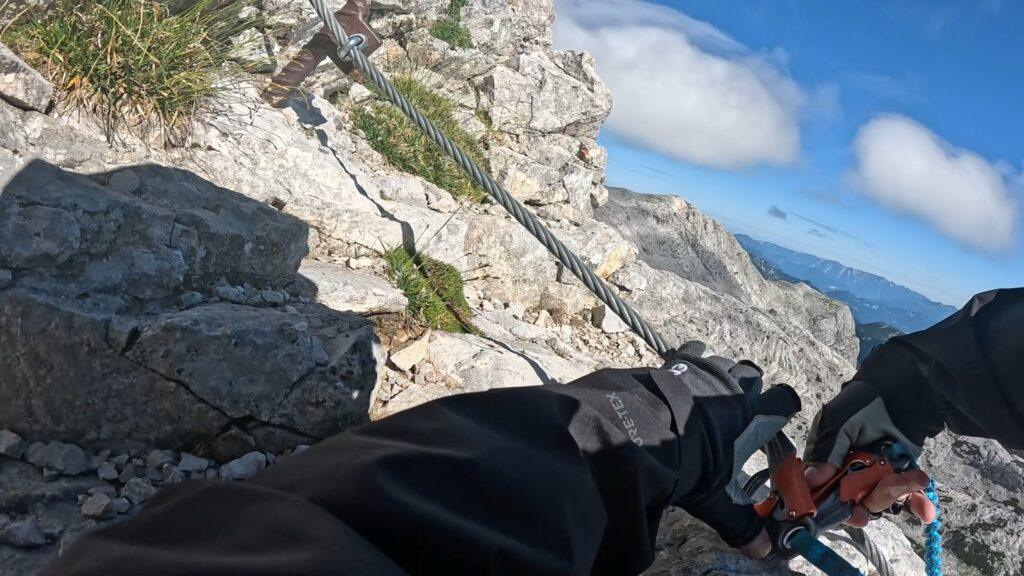
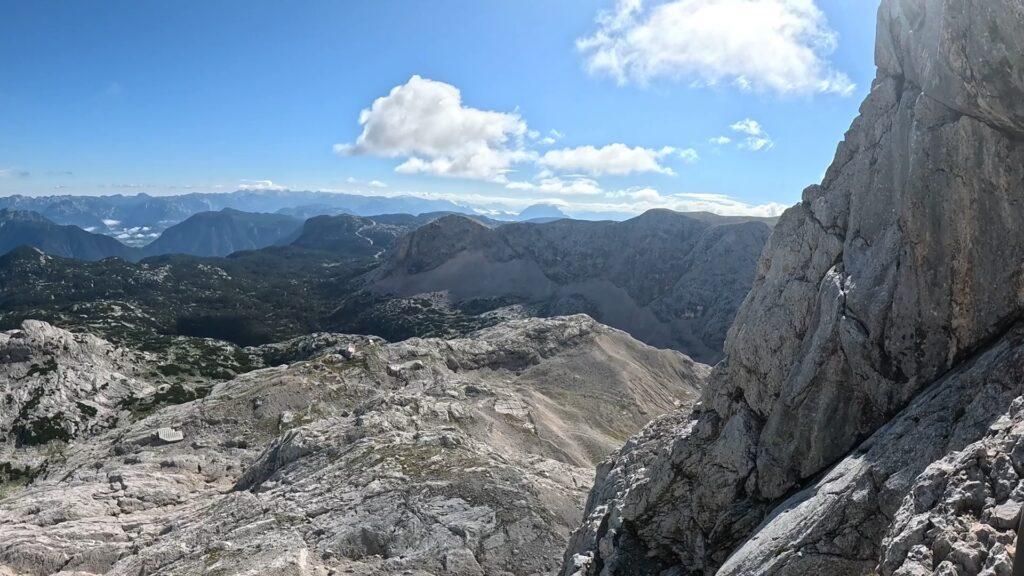
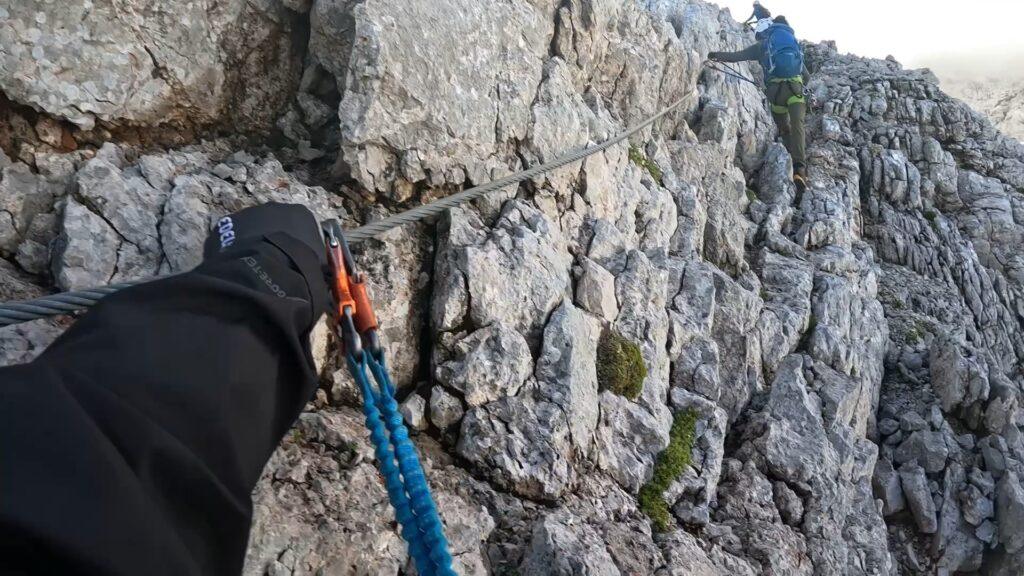
The climb itself involved many pauses, where I could enjoy the surroundings, yet I was also somewhat anxious/nervous. The via ferrata itself isn’t challenging and the climbing is quite easy. The most challenging part involves a section, where I had to lean outwards for a small bit, which was still quite weird for me at first, but it also boosted my confidence a lot 😁. At the end of the climb, I was greeted by the summit cross and a cold breeze.
The climb itself involved plenty of pauses to enjoy the view, though I also felt a little anxious and tense. The via ferrata isn’t particularly challenging, and most sections are quite easy. The trickiest part was a short section where I had to lean backward — a strange feeling at first, but one that boosted my confidence once I managed it 😁. At the top, we were greeted by the summit cross and a cold breeze.
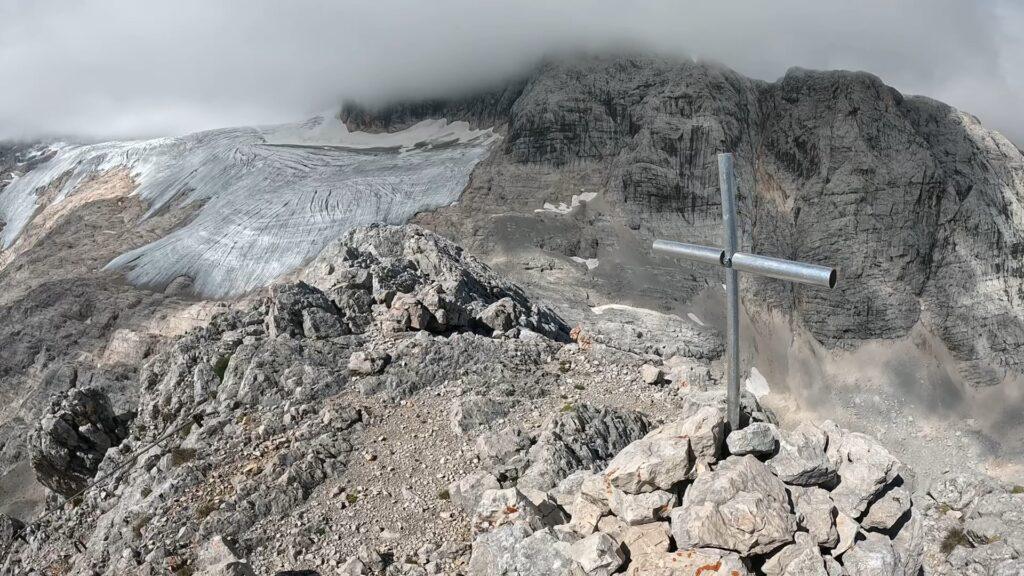
Something I only realized later: this was actually the first time in my life I had touched a summit cross. On my first big tour in Switzerland, I had walked right past several crosses without ever going up to them 🤣😅.
At the summit, we celebrated our first via ferrata ascent in the Alps and enjoyed the panoramic view from the Schöberl (2,426 m). We spent a while up there, had a small snack, and learned more about how quickly weather can change in alpine terrain — and a few interesting facts about the Hallstätter glacier (more on that later).
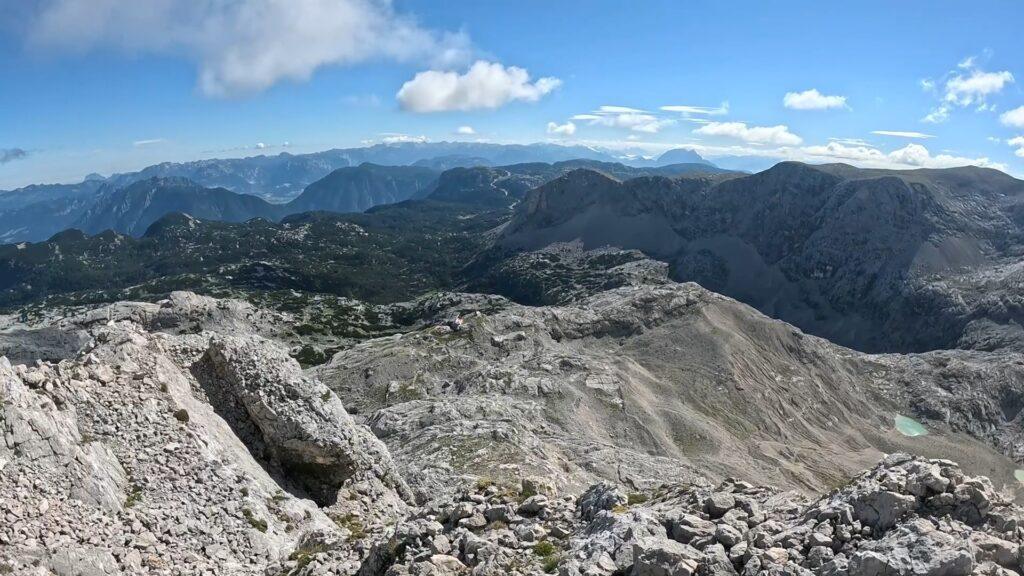
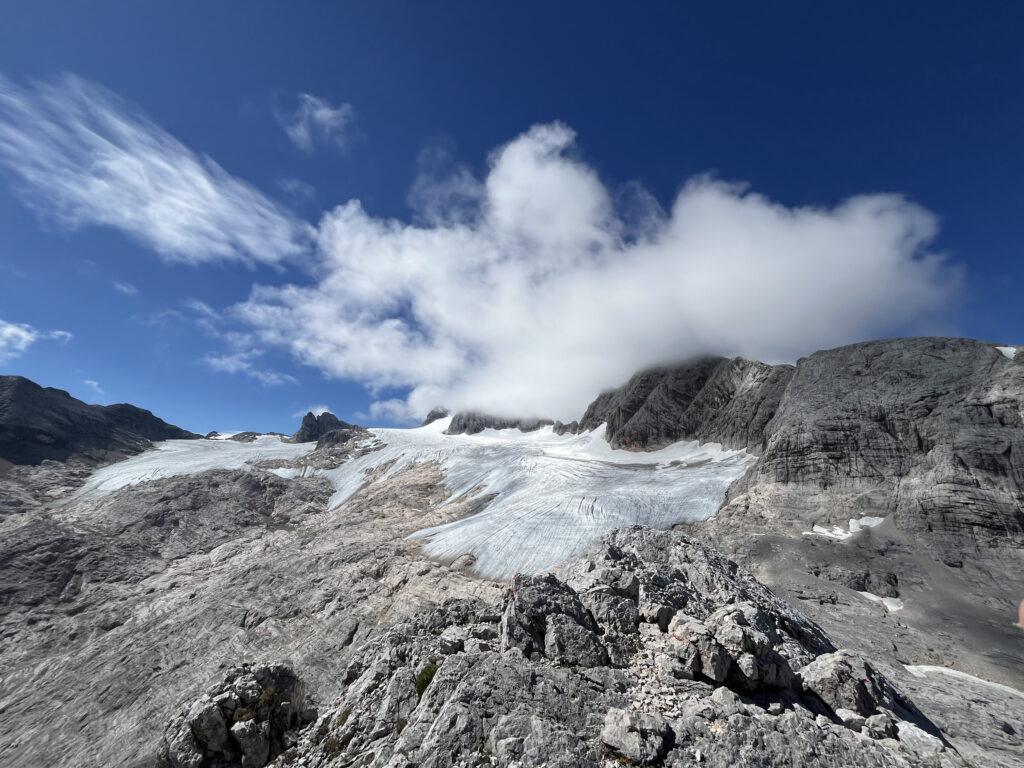
Going down is usually harder for me than going up 😅 — and although I don’t recall the descent as particularly difficult, it still required focus. I’ve never felt as comfortable climbing down as climbing up, as my legs need to absorb more force, which stresses joints and tendons, and, of course, a misstep moving downward can usually have more serious consequences than a mistep moving upward 😬.
In sport climbing, you usually get lowered down; in bouldering, you might climb partway down before jumping off. Actually climbing down under your own control, though, is a different skill entirely — one I still want to improve. Being able to read footholds, staying relaxed, and trusting your balance are key if you want to enjoy it fully 😁. Descents also come when you’re already tired and less focused — which can make them even more dangerous than ascents.
After the descent we’ve went back to the Simony Hütte while looking for the right path by following the cairns and or red marks, although sadly due to having an impaired red color deficiency I could not see these markers with my sunglasses 😩. Back at the hut, I enjoyed another lunch break.
On our way back to the Simonyhütte, we followed cairns and red waymarks, because of my red–green color weakness, I couldn’t see the red markers properly with my sunglasses 😩. Back at the hut, I enjoyed another satisfying lunch.
Top roping in the afternoon
In the afternoon, we headed to a small climbing area for rope climbing practice using the Munter hitch. Our guide had set up four routes, and we split into a two and a three-person group, taking turns climbing and belaying.
On my very first route, I managed to cut open several fingertips 😅😭 while climbing through sharp cracks on the technically hardest route. Our coach also gave us an unusual training tip: try climbing with only one hand!
On the next routes, I also tried relying only one-hand — though at a few points, I used my other hand a little to avoid hitting the wall 🤣😅. My partner handled the exercise impressively well.
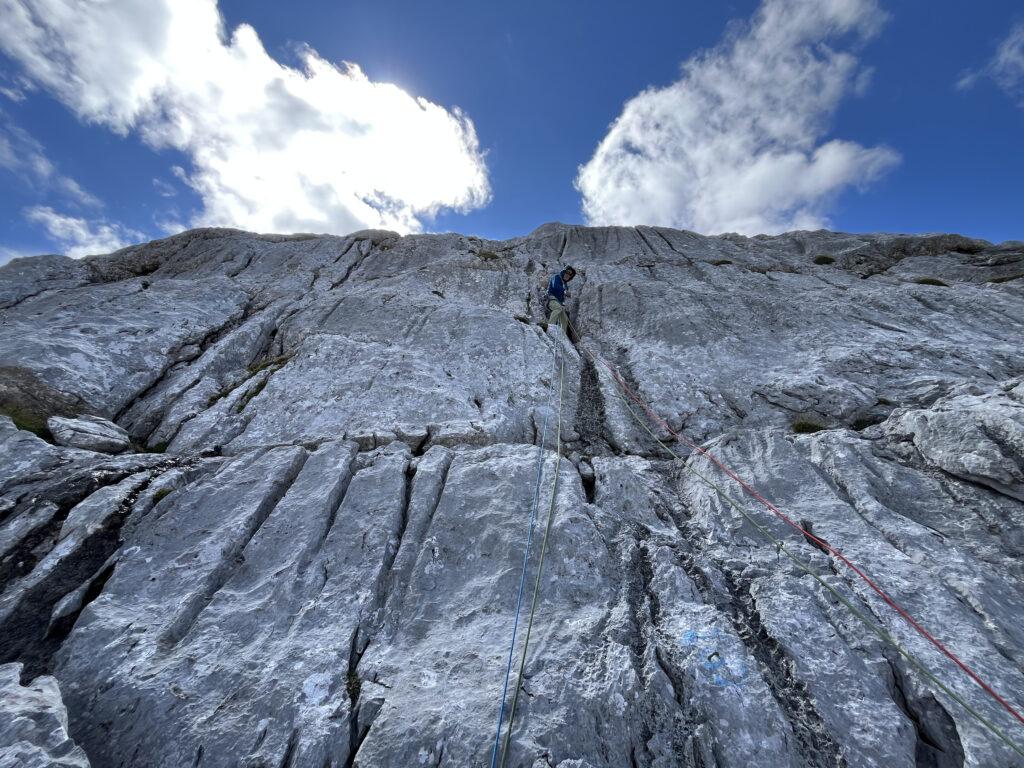
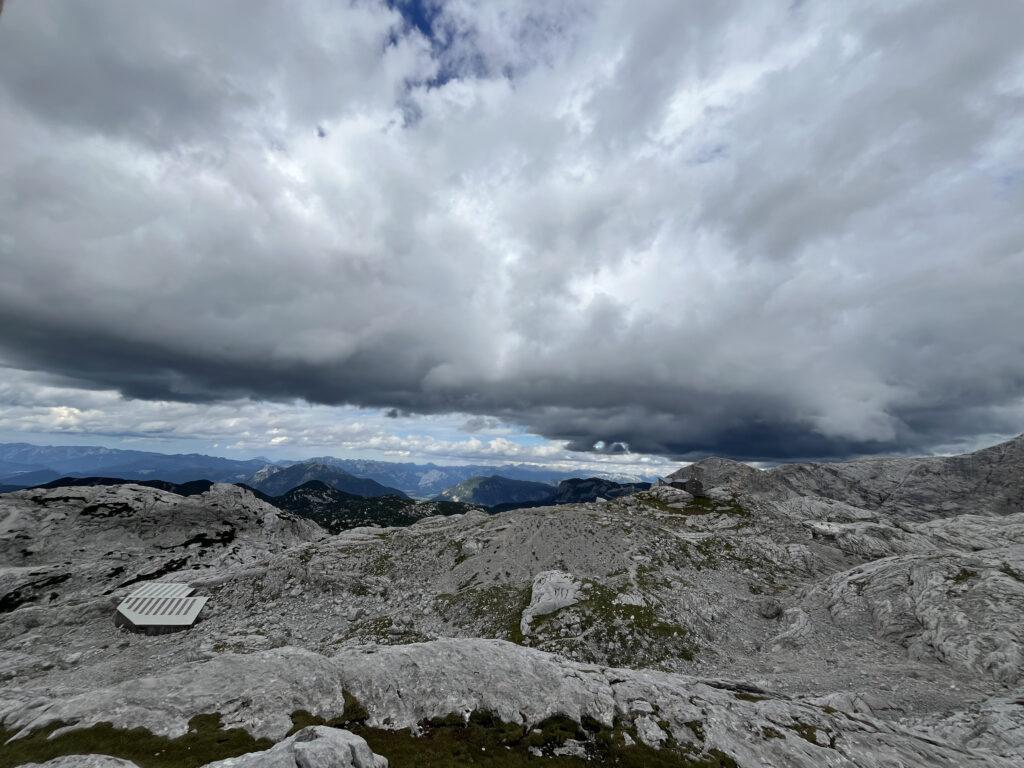
Finally, we also tried the one-hand technique on the first route, but with the weather turning, it became our final attempt of the day. As I climbed higher, I struggled to find good footholds, slipped several times, and slowly ran out of strength. Eventually, I gave up before reaching the top. This was quite frustrating, but also a valuable lesson 😩😄.
Meeting an ibex
On the way back to the hut, we encountered an ibex! Since it didn’t run away (they rarely do), I took far too many photos 🤣 — but I also got a wonderful shot of me with the ibex in the background 😍, something I’m still grateful for.
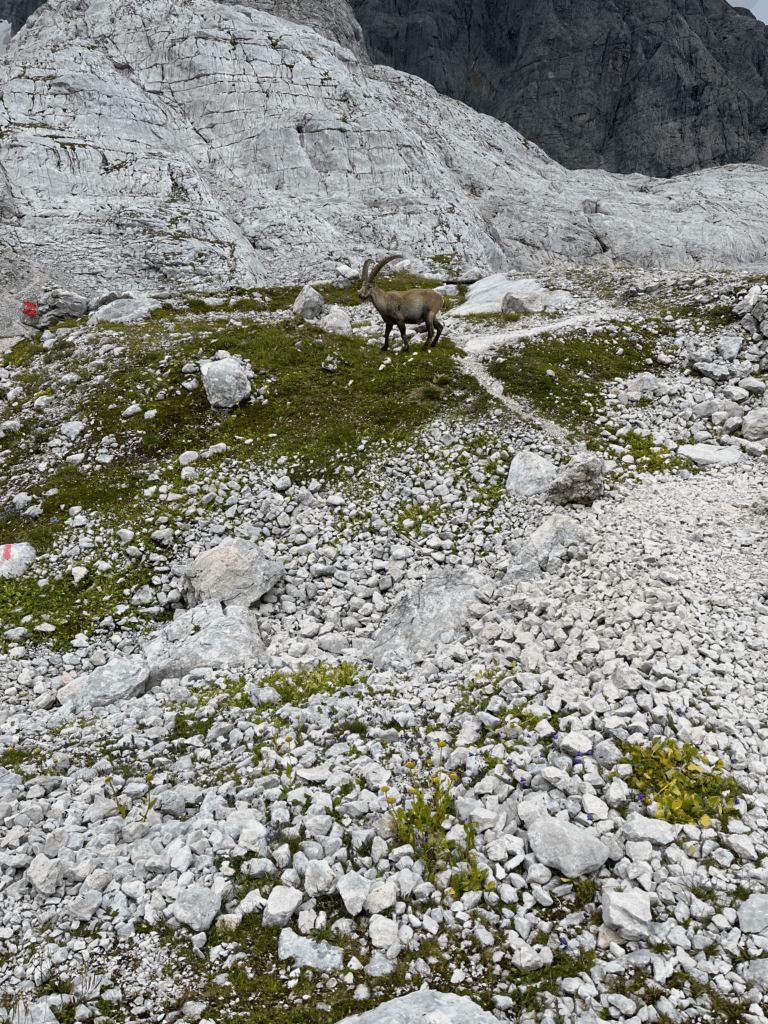
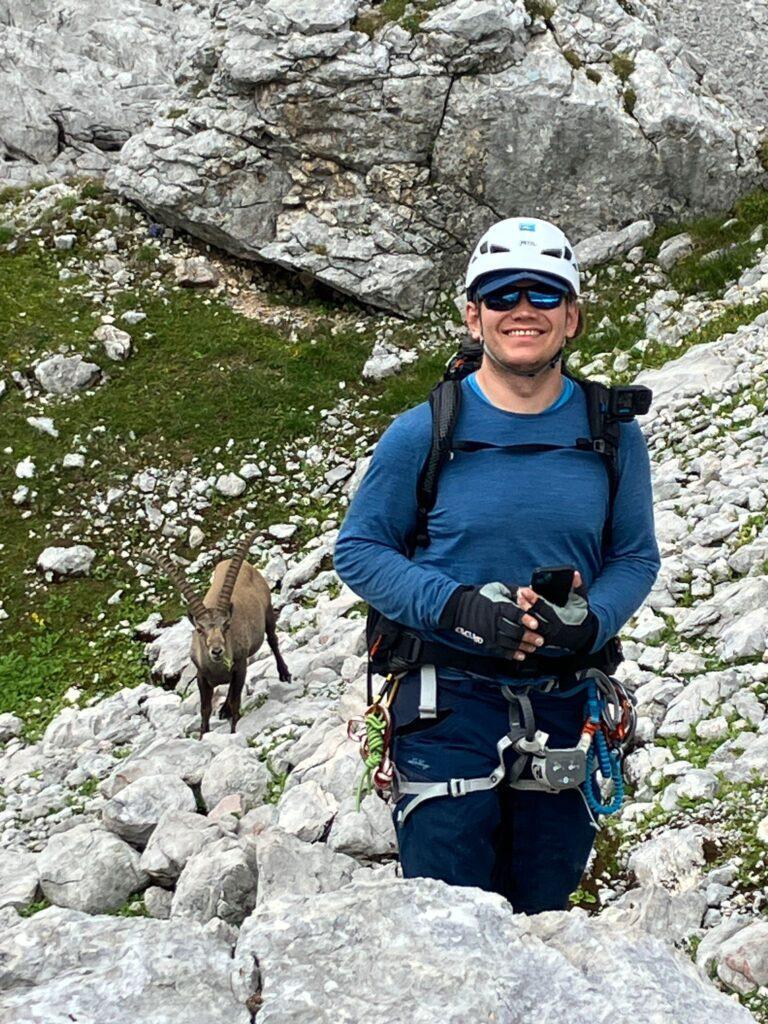
Later, some of us wanted to visit the Eissee — one of several small rainwater lakes on the Dachstein plateau. I saw someone of our group already heading there and hurried to catch up, but when I realized someone else was missing, I turned back to the hut. Then, just to be sure, I repeated the same thing a second time 😅 — without ever making it to the Eissee, altough I encountered several more ibex 😊. Sometimes, I’m just a bit weird 🤣.
We ended the day with another nice dinner and received more equipment — ice axes, crampons (which we adjusted right away), and an ice screw. The evening closed with more games and laughter 😊.
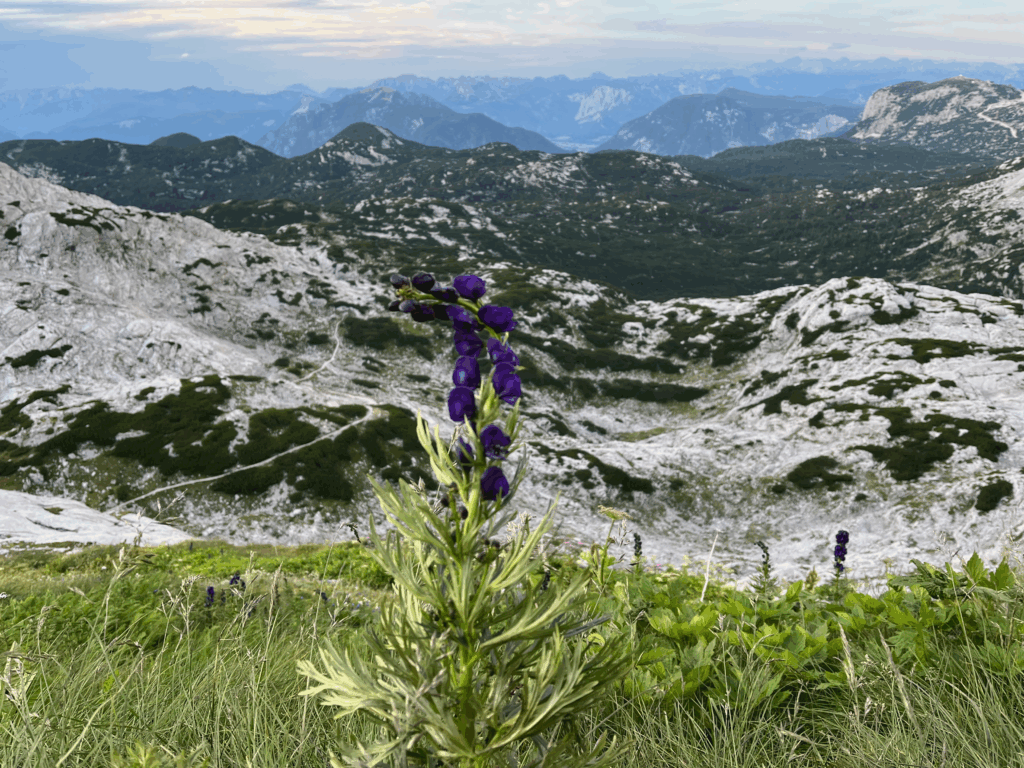
Learning to tame the ice
During the third night, I slept worse than the night before, but breakfast was still great — and this time, I also packed some bread for the trip. The plan for the day was to learn how to walk on the Hallstätter glacier and master the essential basics for glacier safety. Another highlight of the day would be abseiling (as a German, I just love this word 🤣) — plus several firsts involving a lake 🫠🤩. The weather couldn’t have been better — almost completely clear skies ❤️.
Approaching the glacier
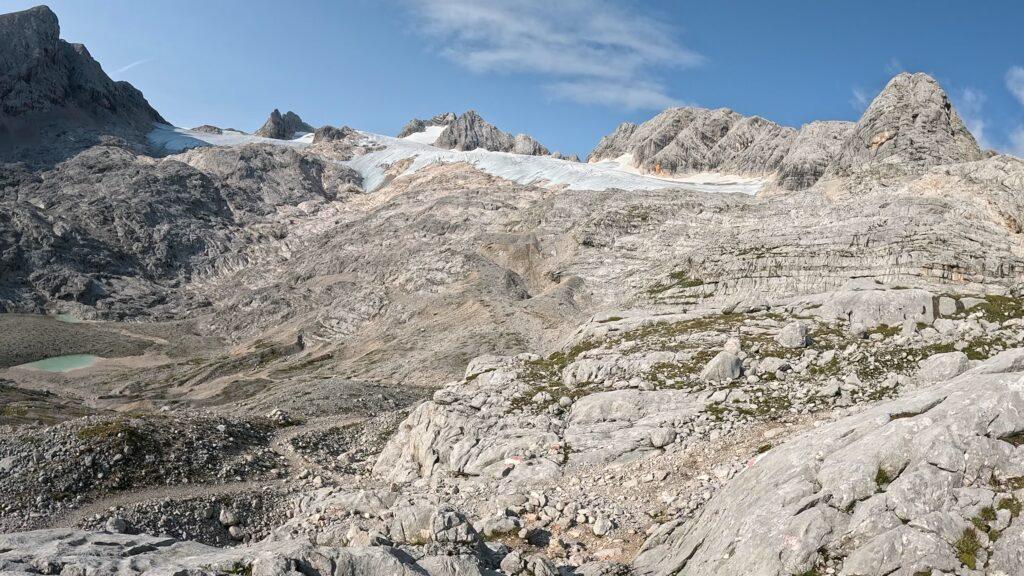
As you can see in the photo above, the glacier lies a few kilometres away, with the Dachstein peak in the centre and the highest visible snowfield in front. In the 1850s, the glacier still reached the plateau where the Eisseen (ice lakes) are located today. The distance from the Simonyhütte to the glacier used to be much shorter.
Getting closer, we could still see how vast the glacier still is — with strikingly visible crevasses. Compared to other glaciers I’ve seen since, it actually looks relatively smooth, without any dramatic features — yet at the time, it was an awe-inspiring sight 😍, and at the same time a bittersweet one, knowing that it’s slowly disappearing 😔.

Hearing our guide’s stories about where the ice had once extended, even just a year earlier, was deeply saddening. I had seen comparison photos before, but seeing it with my own eyes and hearing those stories while standing there was something entirely different.
I’d like to say nothing is certain, but this time I fear the end of this glacier is already sealed — it’s only a question of how long it will remain 😩.
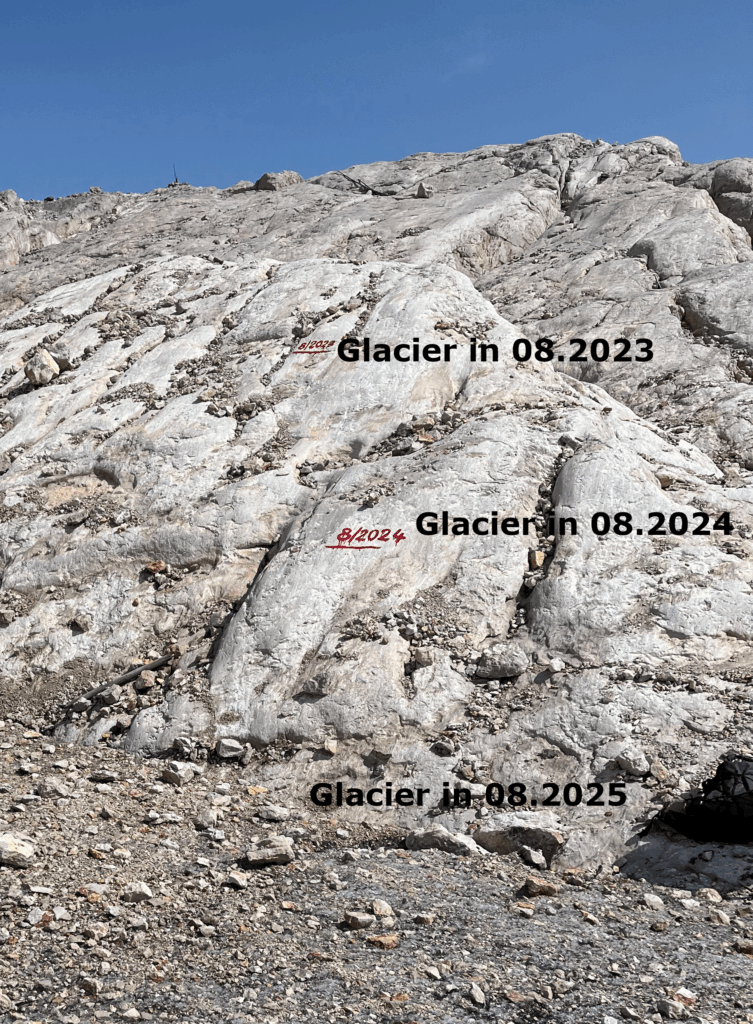
Glacial melting
On a rock face next to the glacier, several markings indicate its former extent in previous years. From these, one can estimate that the glacier has been retreating by about two meters per year.
The path down to the glacier was relatively steep. Our guide first checked whether it was safe to access the ice from there. It turned out to be a good entry point. On the icy plateau below, we took out our crampons and ice axes, and carefully tightened the crampons on our boots.
Walking on ice
Then we began walking on the glacier, leaving our backpacks behind. Each step had to ensure that all spikes of the crampons bit firmly into the ice. We walked up and down, sideways, using the ice axe on the uphill side for balance, even crossing a few smaller crevasses 😊.
We practiced front-pointing in a small dent in the ice, using the front spikes to climb steeper sections. Then we learned how to use the ice axe to carve a hold in the ice and pull ourselves upward. Afterwards, we practiced using the ice screw and how to fix it properly 🤩.
There were also many dark clumps scattered across the glacier surface — out-washings from the atmosphere. They made me realize how tangible air pollution becomes when you see it frozen into the ice.
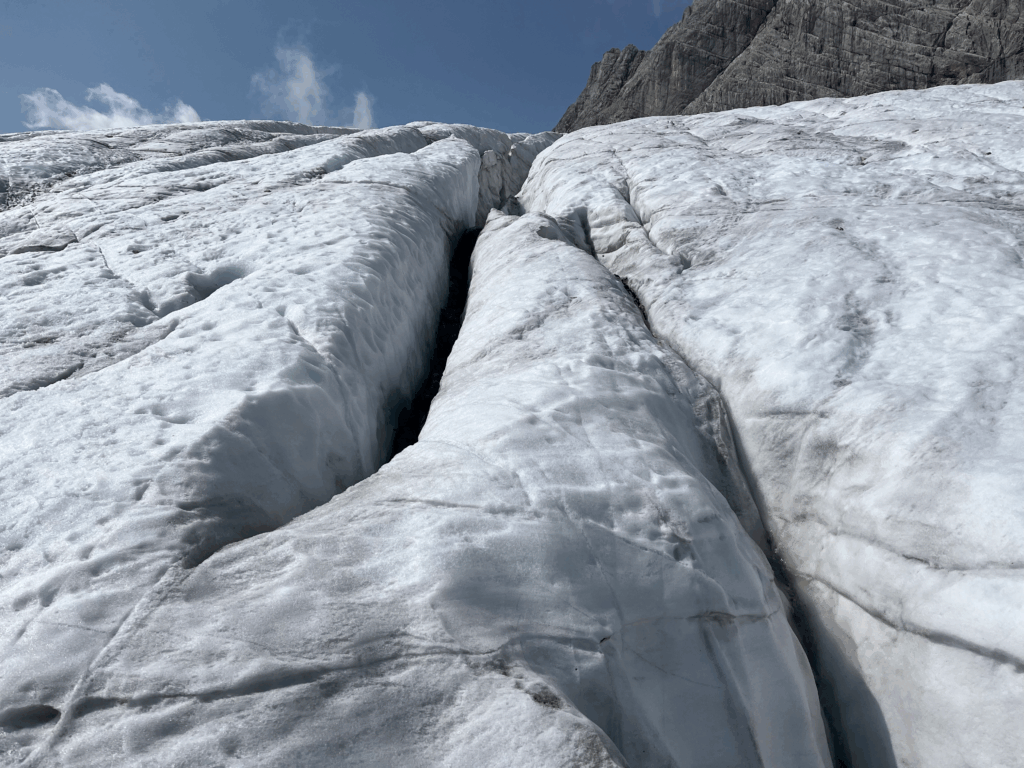
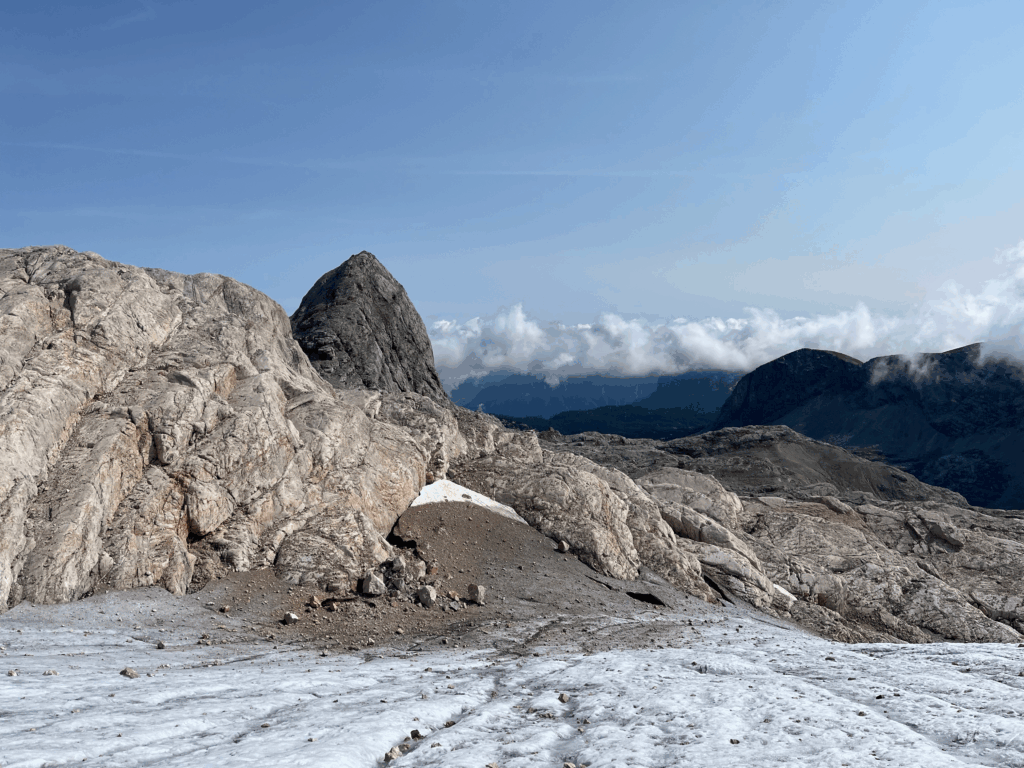
Afterwards, we took our backpacks again and formed a roped party of six, keeping about eight meters of rope between each person. The goal was to keep the rope neither too tight nor too loose — ideally, only the middle part of the rope should touch the ice. (I definitely got better at this on my next tour 😅.) It wasn’t easy and required real coordination between us.
Our guide demonstrated how to rescue someone from a crevasse: if someone falls in, the others must immediately stabilize the rope. The person behind the fallen climber attaches a Prusik knot to the rope, clips it to the harness, and detaches the direct connection. Then, using the Prusik, they move closer to the crevasse, giving clear commands to the team — apparently, I wasn’t loud enough 😅 — so everyone can pull in sync to haul the person out.
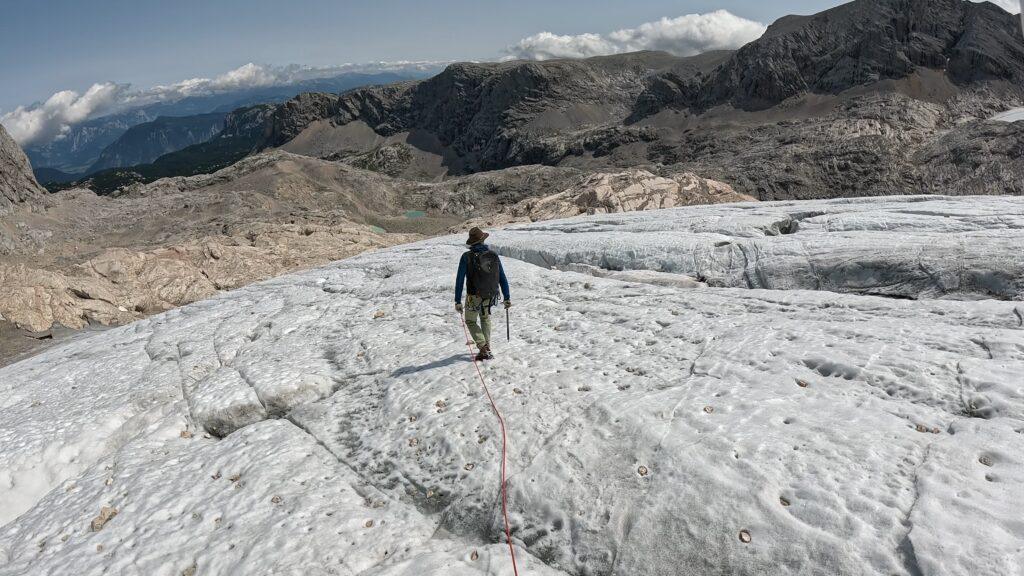
This maneuver only works with at least four people, and only if the one in front or at the back falls. I even asked what would happen if someone in the middle fell into a crevasse — but I can’t remember the answer anymore. Ironically, about a month later on another tour, I did fall into a crevasse myself (only hip-deep 🤣) — while being in the middle of a four-person team. Luckily, I was able to haul myself out 😁.
After leaving the glacier, we removed our crampons and let them dry in the sun before packing them away. We had a quick snack and began heading back toward the hut. On the way, we came across a striking line of fossils embedded in the rock 😍 — a clear band full of ancient shapes.
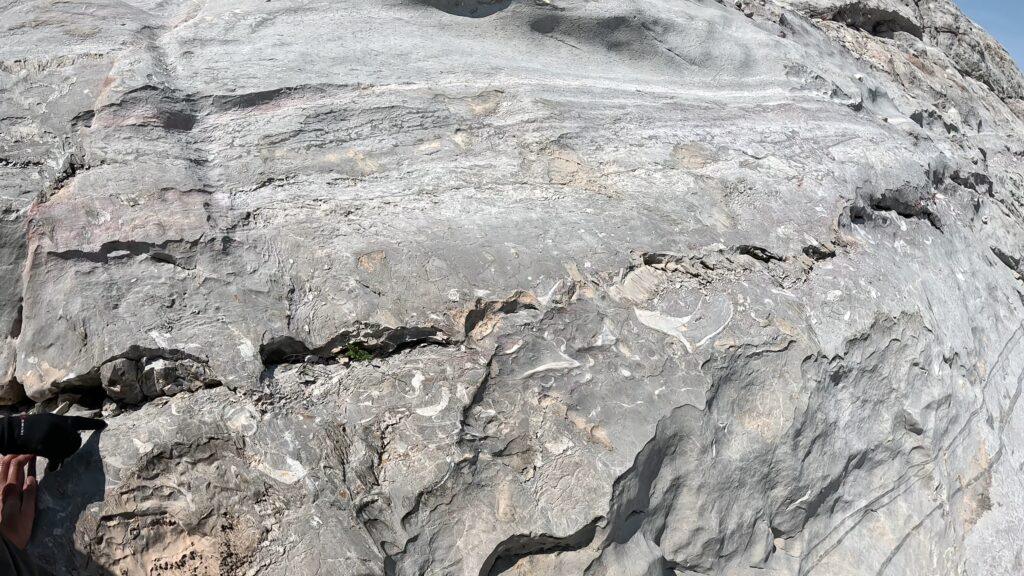
Going for a swim
At a crossing on the way back, we could easily detour to the Eissee. Two people from our group decided to take a swim during the lunch break, so I joined them, as I wanted to give cold-water bathing a try, but lacked the courage to do it on my own. At that time, I was still a terrible swimmer 😬 (a few months later I became a pretty good one 😁 — and now I go cold-water swimming regularly, even when it’s around 10 °C).
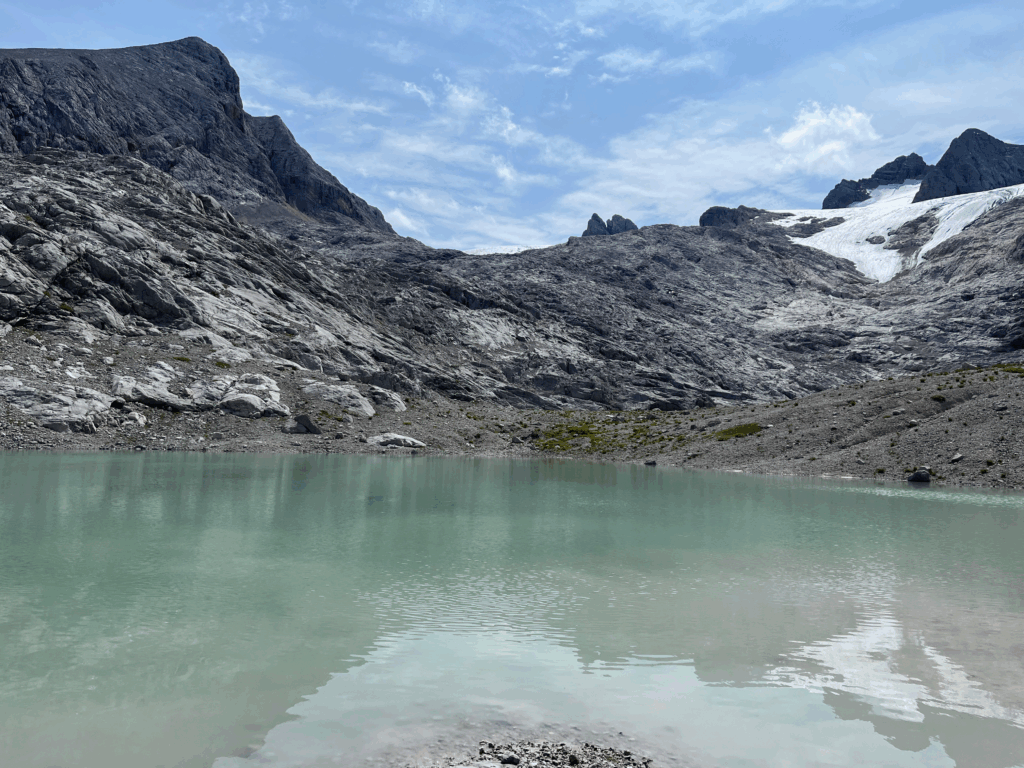
Recently, I’ve realized this wasn’t just my first time going swimming in cold water, but also my first time going swimming in a lake and my first time going swimming naked 😅🤣 (but so far not my last time). I was definitely surprised about how warm the water felt, but I did not swim very far and for very long – as I was still struggling with the technique and felt very insecure and a bit afraid of drowning 😬🤣. Afterwards I felt quite empty and we still had to walk a bit upwards towards the hut – which was quite exhausting 😅.
I’ve realized since then that this was actually my first time ever swimming in cold water — my first time swimming in a lake — and, well, also my first time swimming naked 😅🤣 (but definitely not my last).
I was surprised how warm the water felt, but I didn’t swim far or long. I was still insecure about my technique and a bit afraid of drowning 😬🤣. Afterwards, I felt empty and the short uphill walk back to the hut felt quite exhausting 😅.
Time for abseiling
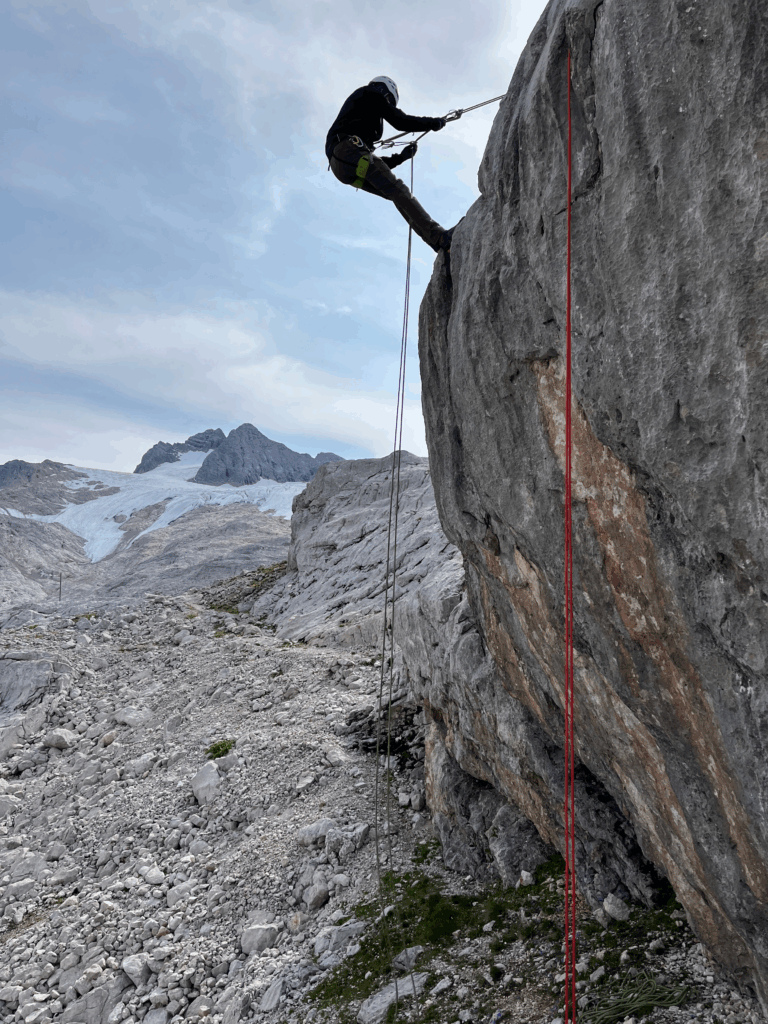
In the afternoon, we practiced abseiling 😊. Near the hut was a rock wall equipped with several anchors as a training site. Three ropes were set up, and after a short instruction, we each got to rappel down. The spot also offered a beautiful view of the Dachstein — perfect for a few photos. Afterwards, we returned to the hut to prepare for the next day’s tour.
Preparing for the Dachstein
The plan was climbing to the Dachstein summit 🤩 on the next day.
We first learned how to read maps, check the weather, and plan a route. It’s not only important to plan the path, but also the time.
Using the map, we estimated a distance of about 5 km with 750 m elevation gain. For timing, we used a base speed of 4 km/h for a group and 350–400 m/h for the ascent. That meant about 1 h 15 min for the distance and around 2 h 15 min for elevation gain. These two times are added, but only half of the smaller one is counted — giving roughly 2 h 45 min (technically 3 h would have been more accurate). Then we added 45 min of breaks, 1 h to climb up and 1 h to climb down from the Dachstein, and 2 h to return to the hut.
We planned to leave the hut at around 6 a.m., so after enjoying the sunset, we went to bed early. I even got a second pillow 😊.
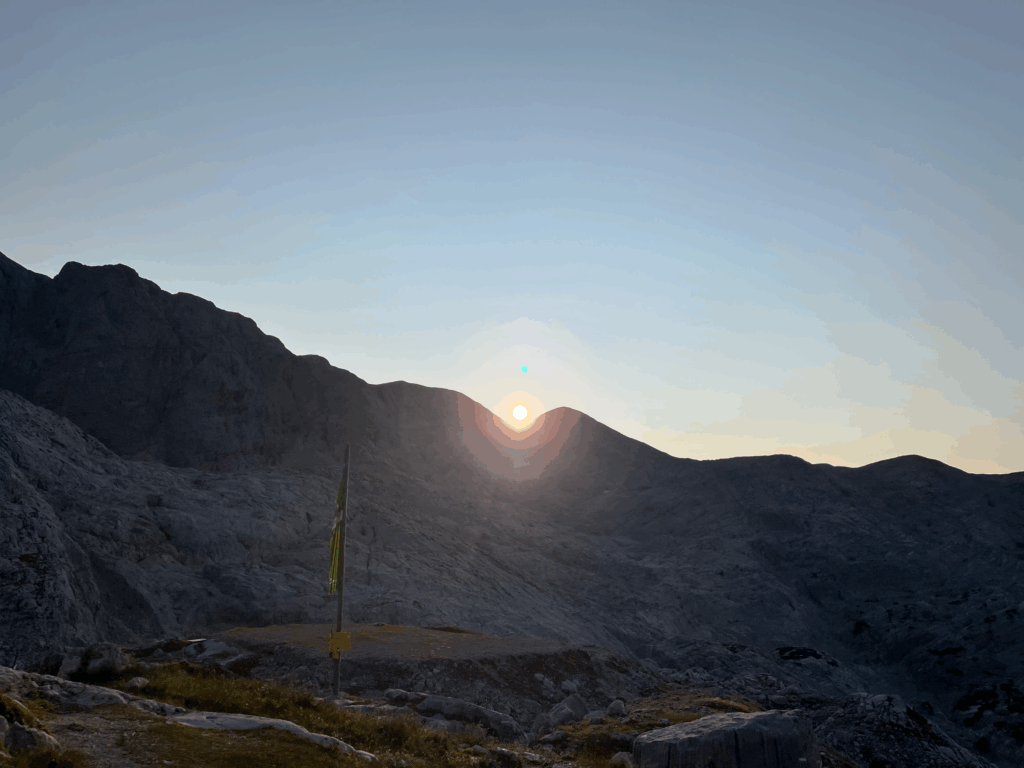
Conquering the Dachstein
After waking up early and having breakfast, we grabbed our hiking poles from their hiding place and began the ascent toward the Dachstein. The weather was perfect again — almost no clouds 😊.
Crossing the glacier
We approached the glacier from the east side, shaded by the mountain, after a long hike across the former glacier bed. Along the way, we spotted a heart-shaped fossil ❤️ and many other visible fossil traces.
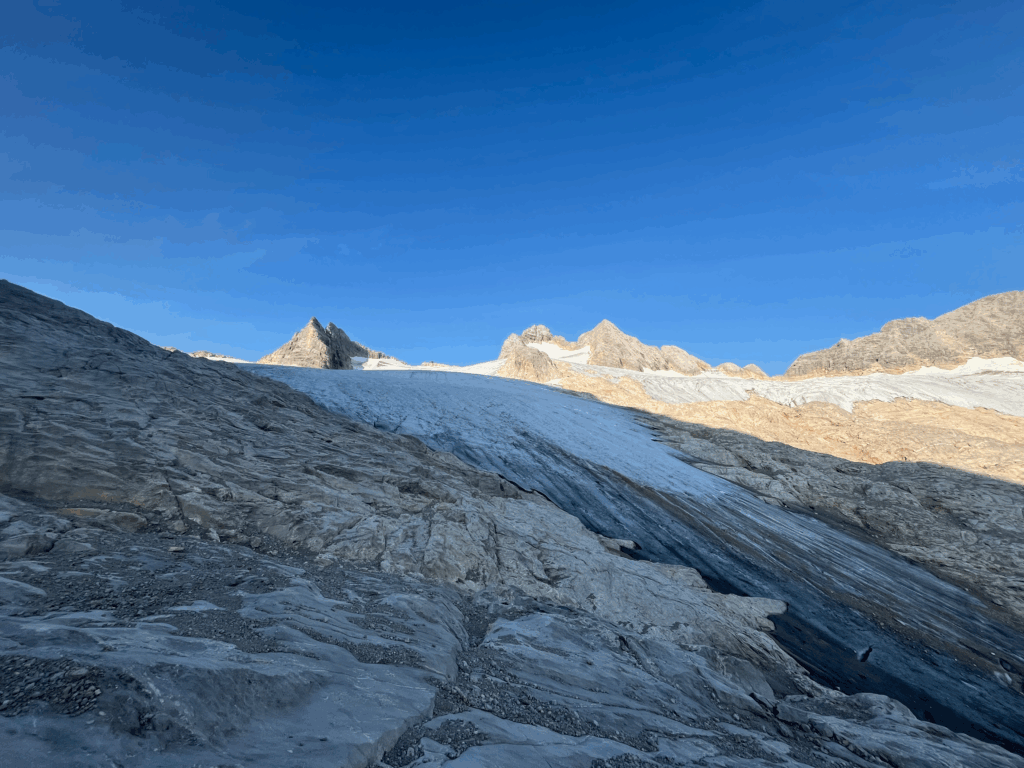
The lower part of the glacier was noticeably darkened by dirt. At the glacier edge, we took out our crampons again, formed a roped party, and began hiking upward. The ice surface was very homogeneous and monotonous — the view ahead looked almost self-similar, with scattered patches of dirt all over.
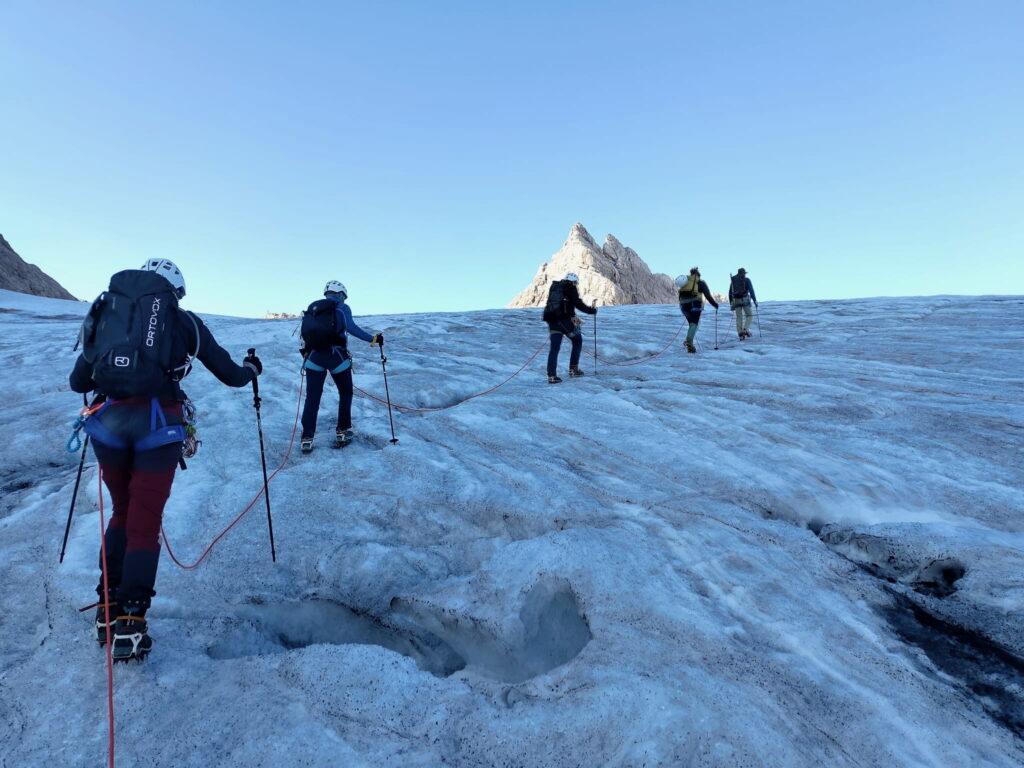
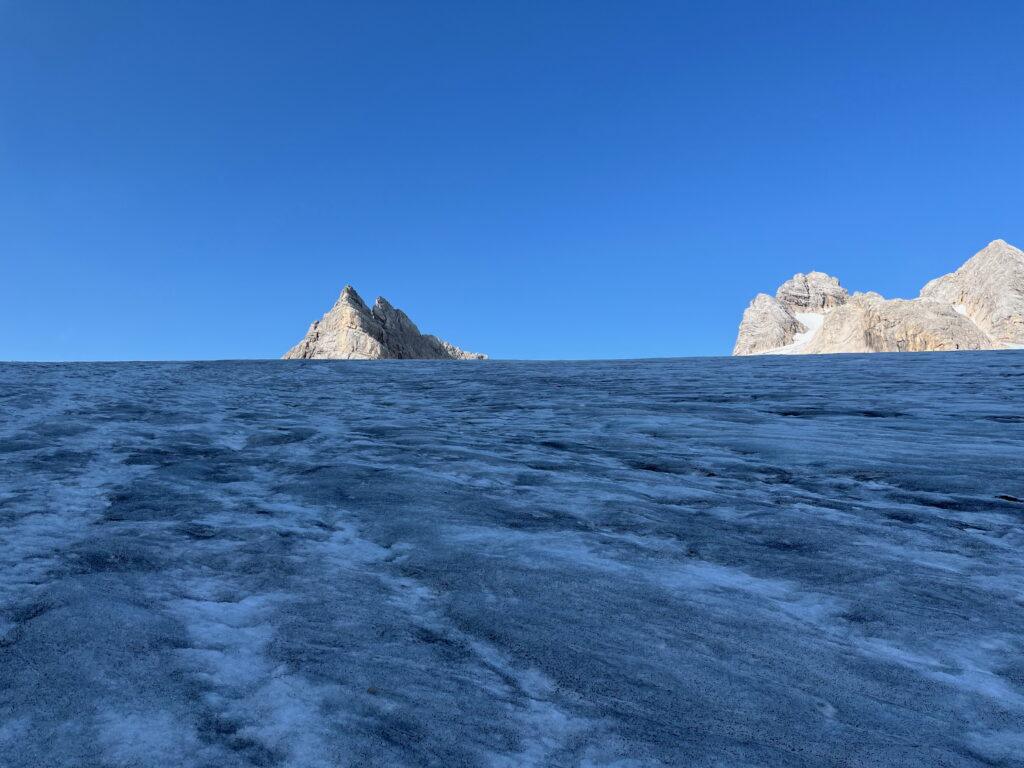
The slope wasn’t very steep, and there were no major crevasses. After some time, we reached a man-made path carved into the ice — it felt like a glacier highway 🥲 — providing easier access from the Hunerkogel cable car station to the Seethalerhütte. The path was wet, especially later on the return trip.
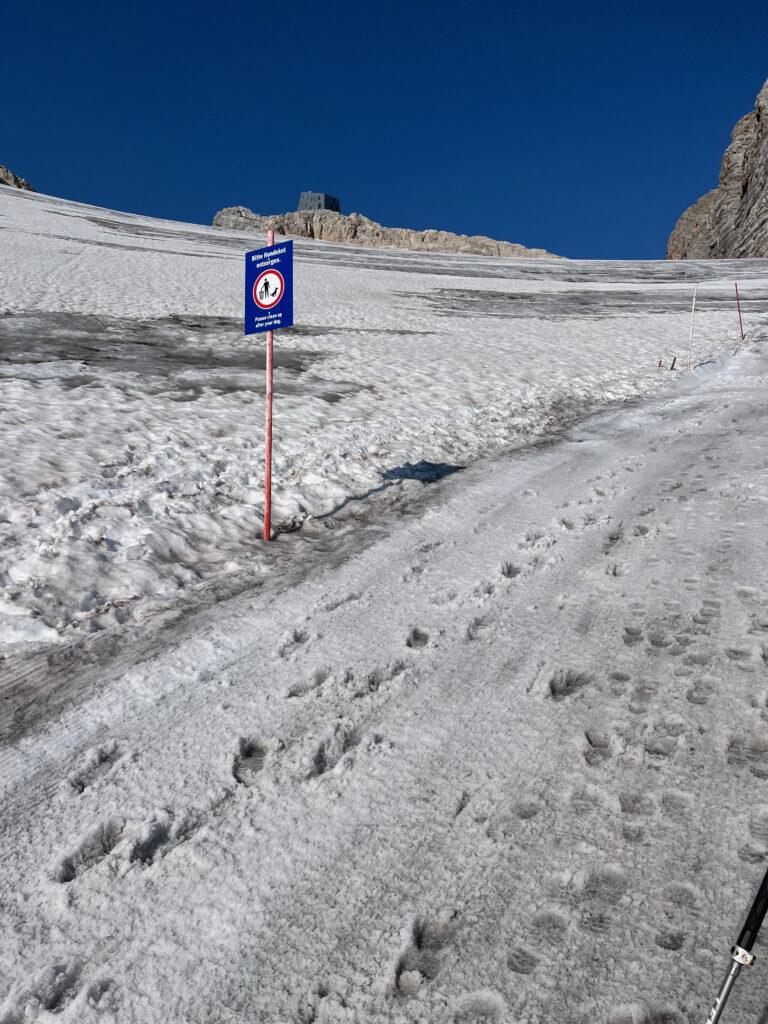
After leaving this “highway,” the glacier became much steeper, and we had to cross a snowfield. For me, this was by far the most difficult and challenging part 😬.
The snow kept compacting under my crampons, causing me to lose footing. It was tiring, frustrating, and honestly frightening — I could have slid downwards and possibly into the people behind me. The final stretch was made easier by a rope to hold on to.
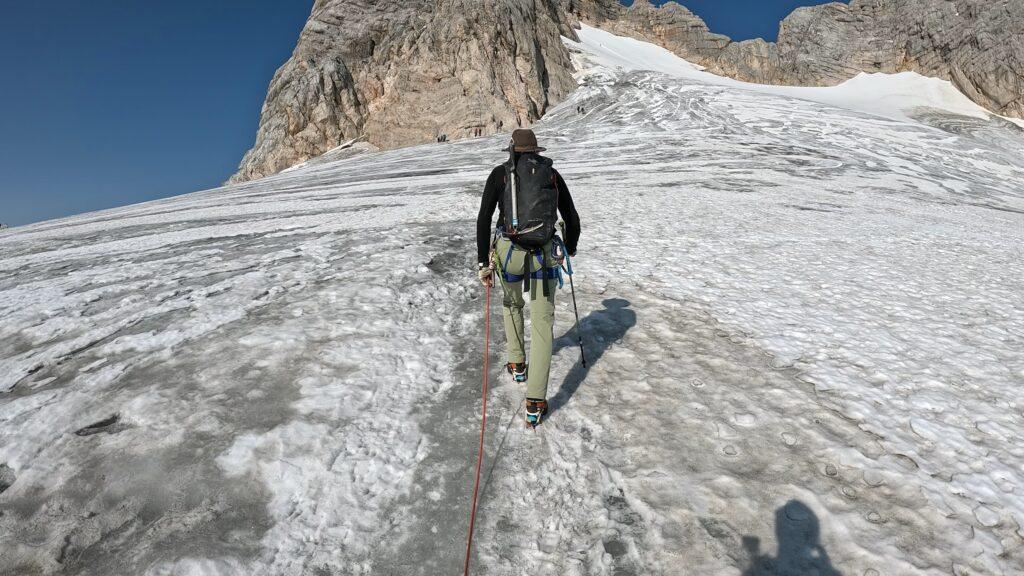
At the top of the snowfield we reached the start of the Randkluftsteig, the via ferrata leading toward the Dachstein summit. We removed our crampons and began climbing.
Climbing to the summit
The via ferrata itself isn’t very difficult, but we did encounter other climbers descending and crossing our line — although, as we were told later, traffic was relatively light that day.
It was also a fun opportunity to talk to more experienced climbers — some of them were going up and down solo, and others were heading for the Schultersteig, a much harder and more dangerous route whose starting point lies right next to a crevasse 😬.
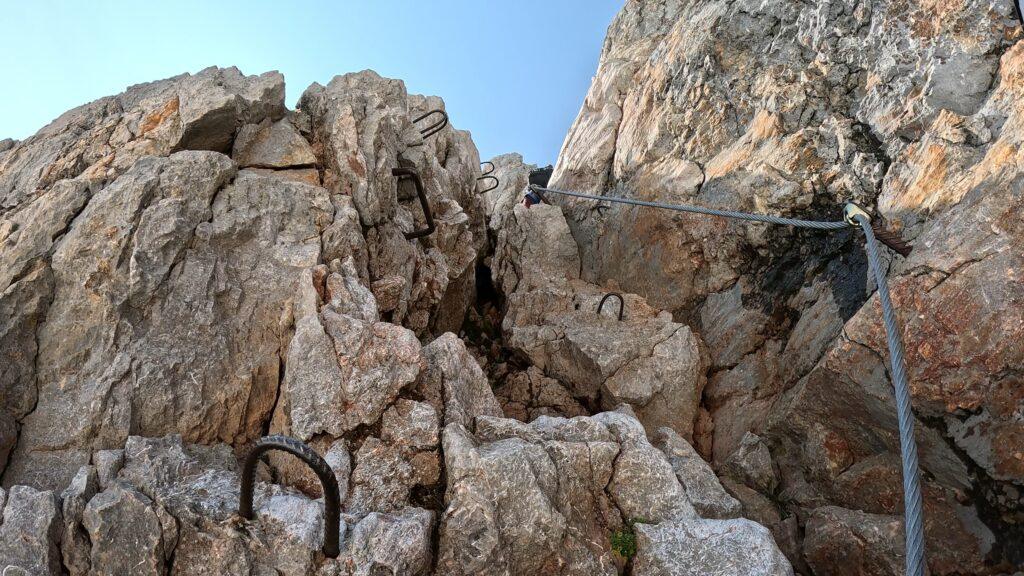
The view on the way up was spectacular 🤩. One feature caught my attention in particular: circular patterns on the glacier surface 😮.

From a speculative point of view 😅, I suspect these formed from meltwater flowing in shallow depressions on the ice — perhaps around the remains of a former moulin or even a doline.
At the top, a large metal summit cross marked the peak of the Dachstein. Several people were already there enjoying the view.

From the summit, we had a perfect view of the Gosau glacier on the southern side. And there, I was reminded again — as someone kindly pointed out — that even though it is “nett hier”, one should definitely visit Baden-Württemberg someday 😊🤣. We also saw several planes flying surprisingly close.
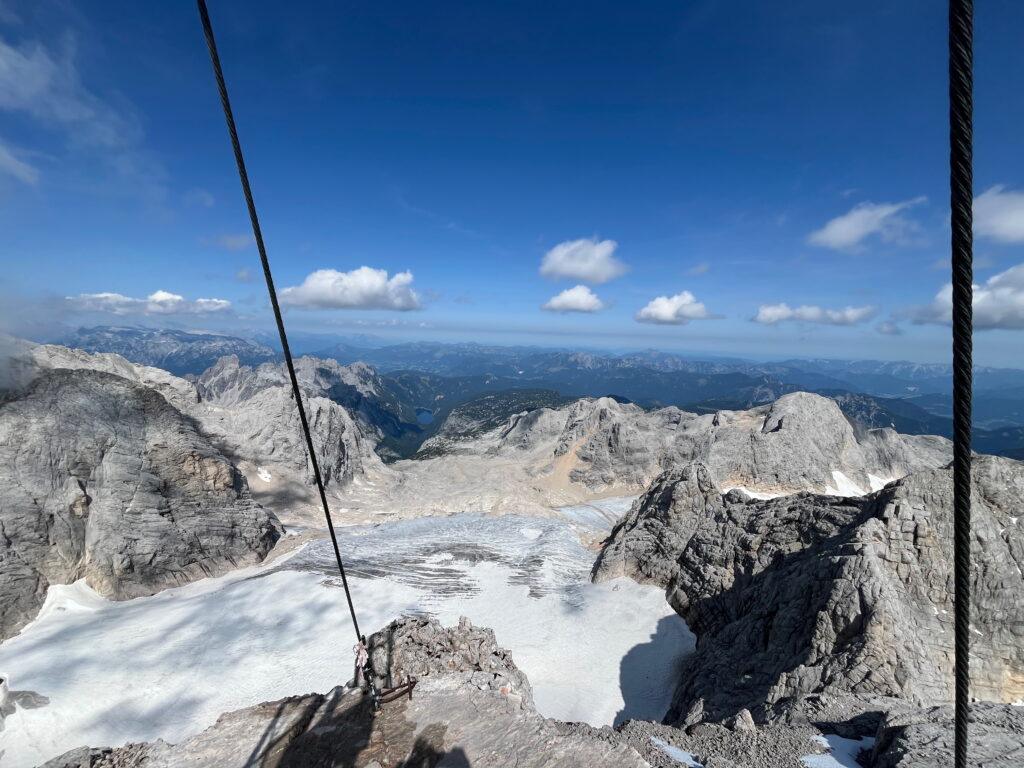

The way back
We descended along the same route. Back at the via ferrata starting point, we put our crampons on again and began descending the snowfield. This time, we formed a roped party, and our guide belayed us from behind — switching positions occasionally to keep us safe.
At the beginning of the Schultersteig (another via ferrata), we saw a family preparing to climb it. Our guide was furious — the entrance is extremely exposed and dangerous, and taking small children up there looked reckless and irresponsible. It fit a theme he often discussed with us.
After reaching the glacier “road,” we headed to the Seethalerhütte, removed our crampons, and enjoyed a dinner 😊 and a quick toilet break. Afterwards we took a short walk to another viewpoint with a beautiful view of the Dachstein’s southern face.
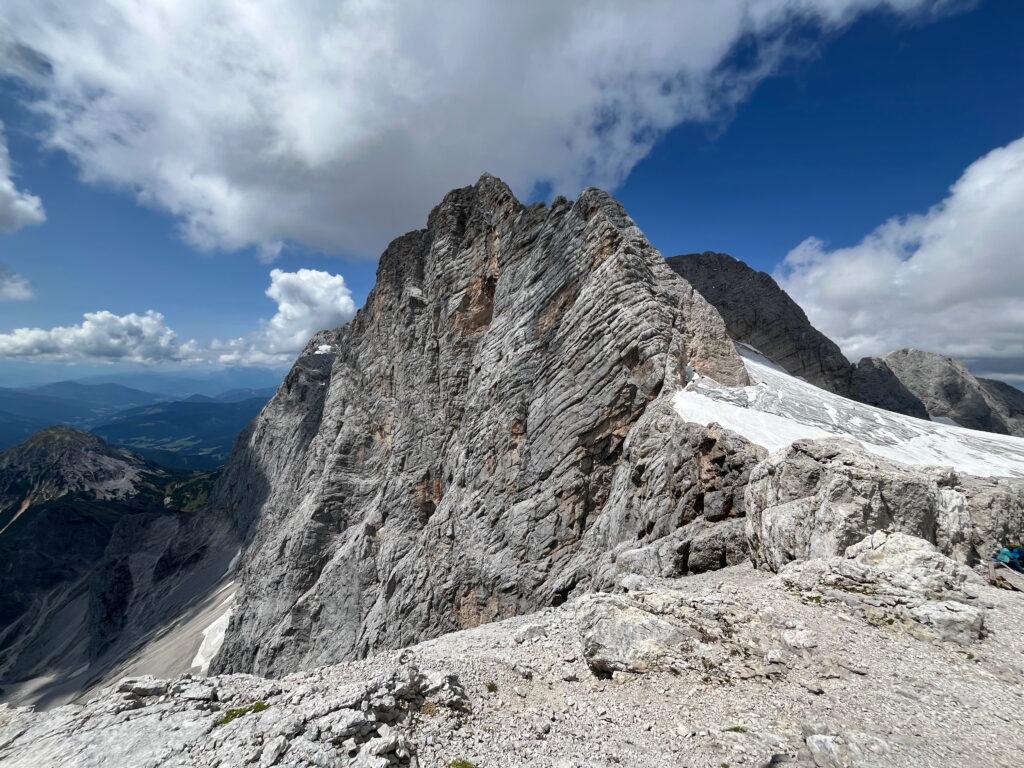
After putting our crampons on again, we began the long trek back across the Hallstätter glacier. This time everyone except me wore gaiters 😅😩 — mine didn’t fit — and since it was midday, the snow had softened and melted, making the return extremely wet.
Halfway across, we formed another roped party and safely crossed the glacier. There we paused and removed our crampons for the last time. During that time, we witnessed a small section of the ice sheet collapsing 😮.
Behind us, a solo hiker crossed the glacier — later we learned he was a former Olympian, possibly in biathlon I think, who often does solo alpine traverses. Generally, solo glacier travel is strongly discouraged: hidden crevasses and snow-covered dolines can be fatal.
On the way back, we encountered several more ibex (German: Steinbock) — magnificent animals. As I tend to drink too much water, I ran dry and was grateful to get more from a companion.
After a long hike, we finally returned to the Simonyhütte. We had originally planned for an eight-hour tour, but in the end it took us more than ten — especially because we underestimated the return time. Fatigue builds up, and this can easily become dangerous.
In the evening, we relaxed. I walked barefoot on gravel to massage my feet — another trick I had learned 😊 — and even tried playing the guitar a bit 🤣. And that night, I finally had my first shower in five days 🫠🥰 — incredibly refreshing.
From a doline to a Steinbock
The last full day of the course began with a visit to the housed doline, where we spent some time climbing several routes — including a grade D via ferrata.
Climbing in a doline

Nothing stays the same
The hut around the doline was built by a former Simonyhütte manager. The doline is around 9 m deep. He once suffered a severe accident here: he tried hanging from one arm — something he used to be able to do easily — but couldn’t hold himself anymore. He fell the full 9 m, breaking most of his bones. Luckily, he survived after being rescued.
By that point, with wounded fingertips and some fatigue in my arms — especially after the first climb inside the doline — I didn’t feel very confident in myself. And that’s always dangerous: once you stop believing you can do something, failure becomes almost guaranteed.
Still, my stubbornness pushed me to attempt the D-rated route. Halfway up, I was moving shakily enoug, so I was secured with a rope. I made it to the top, but it was exhausting and my movements were stiff 😩.
Looking back, I think I needed a bit more arm strength — but far more importantly (as I would later learn through swimming) I need to trust my feet more, stay calm, relax, and not lose confidence. For now, D-rated via ferratas feel a bit too risky for me to truly enjoy — but that may change one day 😉.
Still, I learned a lot of new movements and techniques by watching others and trying things for the first time 😊.
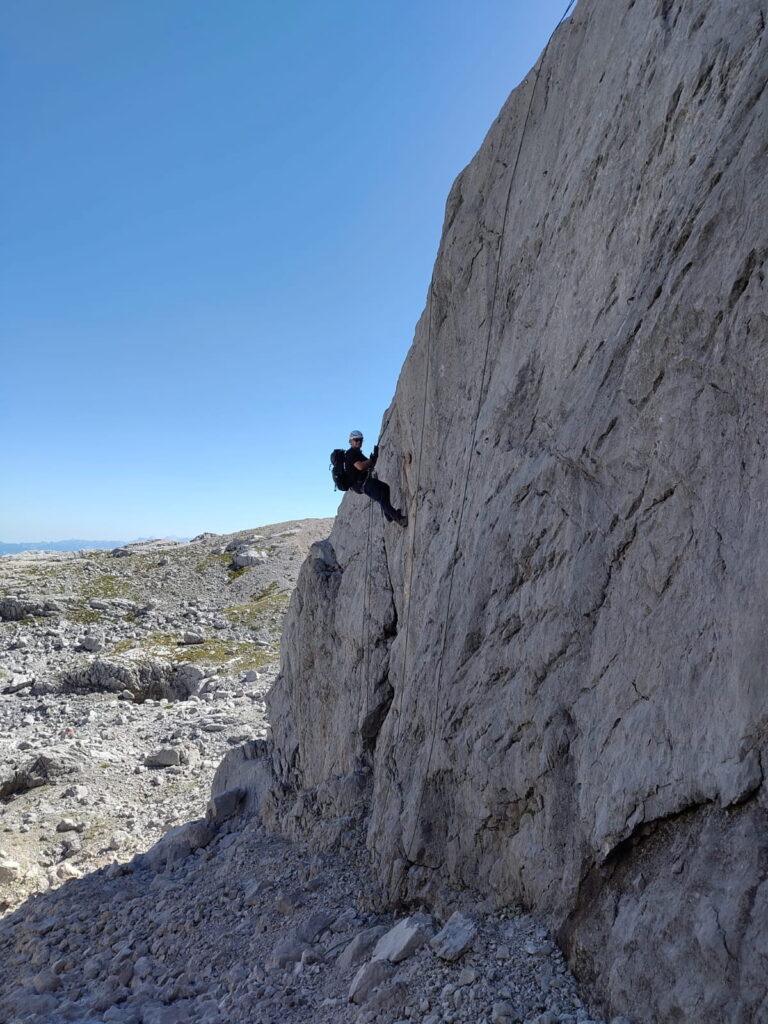
Afterwards we went to another spot for abseiling 😊. This time the descent was longer, and we used two different routes. I had forgotten my abseil device, so we had to improvise by attaching them to the rope after abseiling.
Climbing the Schöberl via Steinbock
We returned to the Simonyhütte for lunch and prepared for another via ferrata on the Schöberl — the Steinbock-Klettersteig — by checking the routes in a book and discussing our approach. Two members of the group chose to stay behind, which I always find admirable: saying no is hard, but when you don’t feel ready, it’s important. Otherwise, the risk rises quickly — something I learned myself on my first trip to the Alps two years earlier.
This was our second time heading to the Schöberl, but now we were supposed to navigate on our own, following markers and cairns — which, due to my color blindness, wasn’t always easy 😅. Near the end of the approach, we chose a somewhat dangerous route over a debris field, where our coach intervened and redirected us to a safer path.
The via ferrata itself became my personal favorite of the week — especially in retrospect. Still, I had shaky moments. At one point, while climbing to a ledge, I couldn’t find stable footholds and ended up pulling myself up using my shin — suboptimal, and mostly a result of my limited hamstring mobility 😩 and poor footing.
Often I relied far more on my arms than on my legs 😩 — another sign of some technical and strength weaknesses.
Going down, I also decided to swing onto a ledge rather than climbing more controlled along a slight overhang. It was technically an unnecessary risk, but I chose it because a more controlled descent felt more difficult. Another reminder of what I still need to work on 😅.
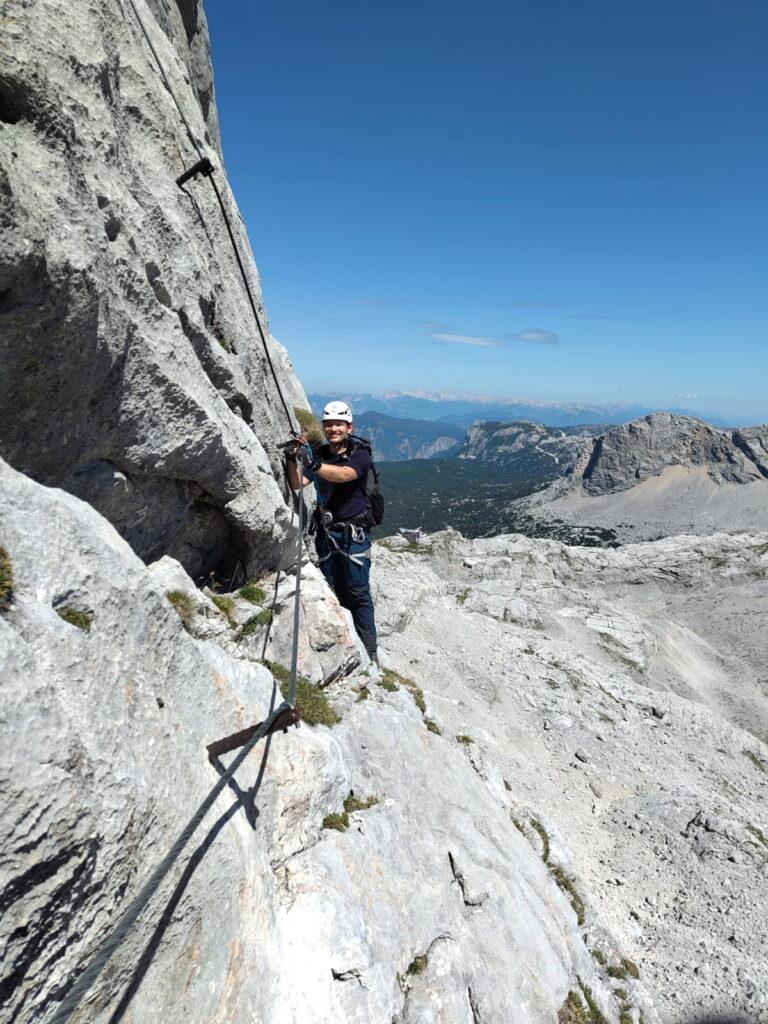
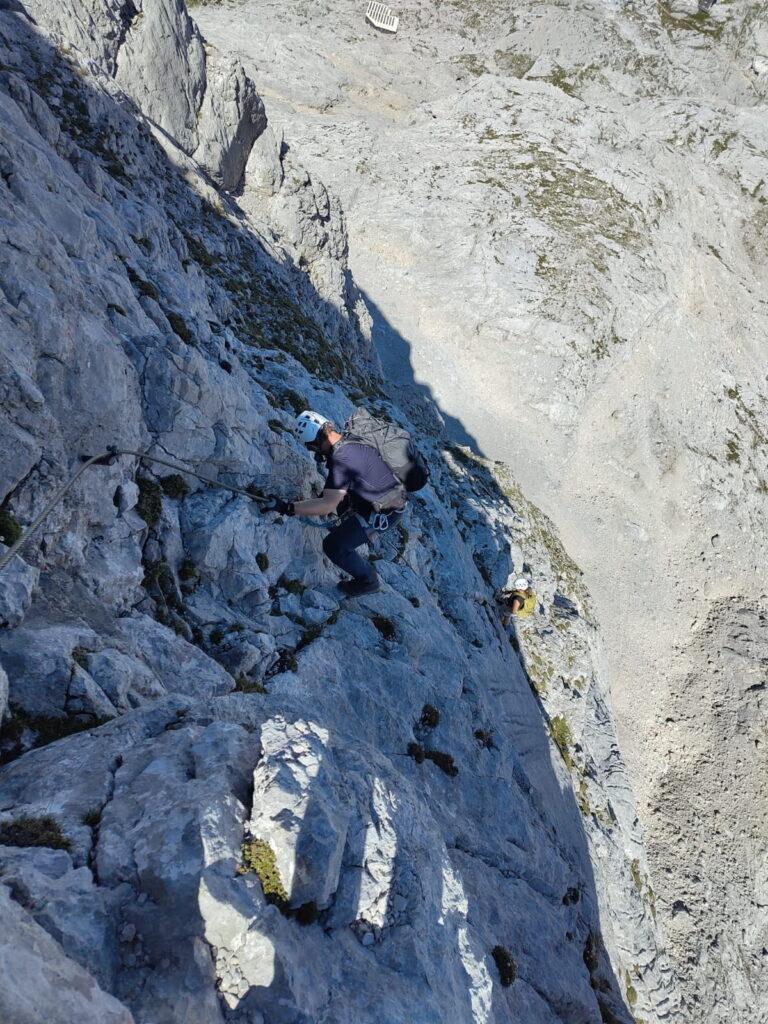
On the way up we had several great photo spots — and as I later learned, there were also pictures of me climbing down 😊. Halfway up, we reached a small den where we rested, talked about winter sports 😁, and just enjoyed being up there.

Being on the Schöberl summit again felt great. The weather was even better — clear blue sky 🤩 — and I didn’t even need a jacket because there was almost no breeze 😊.
The mistake I had made earlier — when I had lost my foothold — was still in my mind. Part of me wondered whether I should take a different descent route, as our guide suggested. But the others preferred the same route down, and a part of me wanted to try descending more controlled, finding better footholds and correcting the mistakes I made earlier — even if I still felt unsure 😅. At least I wasn’t overconfident 😁.

After climbing down, we headed back to the Simonyhütte. I was still a bit demoralized and distracted by other thoughts — which didn’t help my mood 😅. But eventually, I reminded myself to take things less seriously. Without failure, there is no growth 😁.
Since the next day would be the final one, I began packing most of my things already. After dinner 😊, we spent the evening outside chatting. We saw lights at the Dachstein and at another path, which confused us at first — but apparently it’s quite normal.
A part of me was looking forward to the next stage of my journey; another part wished I could stay longer, explore more, and continue growing there. Some of us were excited about returning to a cozy place, one was starting a multi-day hike the next morning, and some felt a little anxious about returning home — to the good and the bad.
Returning to the jungle
After a final breakfast at the Simonyhütte, we began our way home — or for some of us, like me, the path toward the next adventure. A part of me was genuinely excited for what lay ahead, while another part felt sad that the course had already come to an end. But that’s life. Even though I’d like to say that nothing is certain, some things are quite certain 🤣.
Back to the green
The weather was perfect again as we headed toward the cable car station. We even came across a few wild chickens that started their evasive maneuvers as soon as they saw us 🤩😂.
What struck me most was the sudden appearance of green — first more grasses, moss, and flowers, then bushes, and eventually even trees 😊. When the ordinary becomes refreshing, you know you’ve spent a lot of time in rocky, barren terrain.
Our coach told us about the Swiss pine (Zirbenkiefer) and how its scent helps with relaxation and sleep. I immediately wanted a bed made of Swiss pine — but since my current bed is still in good shape, I settled for Swiss pine spray on my pillow. Now the scent of Swiss pine is what I fall asleep to every night ❤️😊 — even when I’m traveling. (Who doesn’t love the smell of pine trees 😁?)

Halfway to the cable car station, we said goodbye to one member of the group who planned several more days of hiking in the region. Along the way, we talked about interesting via ferrata routes — one person was especially excited about trying multi-day via ferrata tours.
At that moment, I still felt unsure about whether I was truly capable of such tours — while also knowing that I’m often too hard on myself.
In a way, that uncertainty is healthy: adventures like these should be approached with respect, preparation, and awareness of the risks and challenges along the way 😊.
The truth is that I had a phenomenal time climbing there, even when I felt tense at times — and I enjoyed it deeply. If there’s one reason to pursue something, enjoyment is certainly an important one.
Even though I still felt uncertain then, I also felt certain about this: I want experiences like these to be part of my life — not necessarily via ferrata, rope climbing, or hiking specifically, but simply being able to go on a tour, enjoy the journey, and ideally share it with wonderful people 😊.
Once we arrived at the cable car station, we made our quick descent to Obertraun. There, we said goodbye to our guide. Technically he’s already retired, and this had been his last tour of the summer.
Sadly, we — or I — completely forgot to prepare a small thank-you present for him 😩. (On my Alps crossing and on the high-mountain tour a month later, the groups did exactly that.)
Time for goodbyes and moving on
At the Obertraun cable car station, I got a lift back to the train station and retrieved the luggage I had left in a car. Then I said goodbye to two more group members.
I spent a bit more time with the last member of our group at the Hallstätter lake, even stepping a little into the water — though this time, I did not try swimming 🤣. Eventually, we parted ways so I could catch my train, which was delayed, causing me to get stuck in the next town. In the following train, I met her again — for another goodbye 😅.

My day ended in Ljubljana — the capital of Slovenia — a little later than expected, with another wonderful trip ahead of me.
The end of one journey is always the beginning of the next.
And in the meantime, we all return to the jungle — whatever that might mean for each of us.
How it shaped me
A couple of years ago, I decided to change the way I approach life — not as someone bound by self-imposed ideals, but with the freedom to choose the path I actually want to follow. Yet anxieties, worries, and lack of experience held me back.
But a lack of experience can be liberating — often referred to as naivety 😂.
My life started shifting noticeably a month before the corona pandemic began affecting life in Germany. I had finally found a way to live with an illness that had strangled me for over 20 years. It still took two more years before I truly began walking the path that led me to become who I am today.
In some sense, even though I’ve lived for well over 30 years, I feel like only the last three years were really living 😊.
For me — and I guess for many of us, maybe even for you — we often choose paths that give us a sense of certainty, because certainty helps us cope with our fears rather than confronting them. It’s not always about running away; often it’s about avoiding confrontations whose outcome scares us.
Maybe it’s doubts. Maybe internalized beliefs about ourselves. Maybe the way we think the world works, or simply the circumstances we grew up in.
A year ago, I would never have believed that I’d go climbing, let alone abseiling — and I certainly wasn’t convinced I’d ever be able to swim properly 😅 (let alone in cold water).
Yet here I am — and even though 2025 still has more than a month left, it has already been the most insane year of my life:
the sheer number of new experiences, the emotions — the good and the bad — and everything I have learned.
This trip was not the tipping point of my transformation, but it was a powerful accelerator. Without it, I doubt I would have started this blog at all.
Since then, I went on another alpine tour (one I had planned before), started attending a swimming course (and soon even one for triathlon), and completed my first competition — a half marathon in the Harz mountains. Technically, it was my first mountain run ever.
More recently, I completed a 55 km hiking event — the Mammutmarsch in Berlin — in under 9 hours and 20 minutes 🤣. I had expected to take 11–12 hours, but I enjoyed the movement so much that I spent much of the time grinning like an idiot 😊🤣.
Now, I’m preparing for my first marathon and I’ve already signed up for my first ultramarathon trail run. For that, I even started changing my entire diet and cooking more myself. Over the past year, I lost around 10 kg — and now I want to lose 10 more in half the time 😊.
On this trip, I was told I seemed quite tense at times while climbing. And although I was partly aware of it, I didn’t yet know how to break the cycle. As my confidence went down, the tension increased — a devil’s loop.
Sometimes we define a “certainty” that ends up defining what we think we can or cannot do.
As I learned swimming, I became more and more certain that I could stay afloat even when things went wrong — drinking water through my nose or mouth, messing up technique, cramping, or simply panicking a little. Through that, I became less tense — and more confident.
The lesson for me is: when you start something new and a voice in you says “I can’t do this”, it doesn’t mean you can’t. It usually just means you haven’t yet learned how to fail safely — ideally in a controlled environment 😅 — so you can grow.
If you try to hang with one hand while only having the strength to hang with two, you will fall — no matter what you think.
But if you want to hang with one arm, you can train for it. You just need to understand your reasons — and avoid becoming a slave to your ambitions.
In the end, it shouldn’t be about achieving arbitrary goals, but about enjoying life 😁.
Next year, I want to go on a tour outside the Alps — I’m considering the Salvaggio Blu on Sardinia — and use everything I’ve learned so far, while learning a lot more about camping. In the meantime, I want to focus more on climbing, write about philosophical topics, and maybe do a few more spontaneous adventures 😉.
If you actually read all of this, I probably owe you an apology 🤣 — and a better story next time 😊.
Thank you for your time, and I wish you all the best in letting go of certainties and exploring the unexpected.
PS: Writing all of this took a lot more time than I imagined 😅 — but I really enjoyed it 😊.

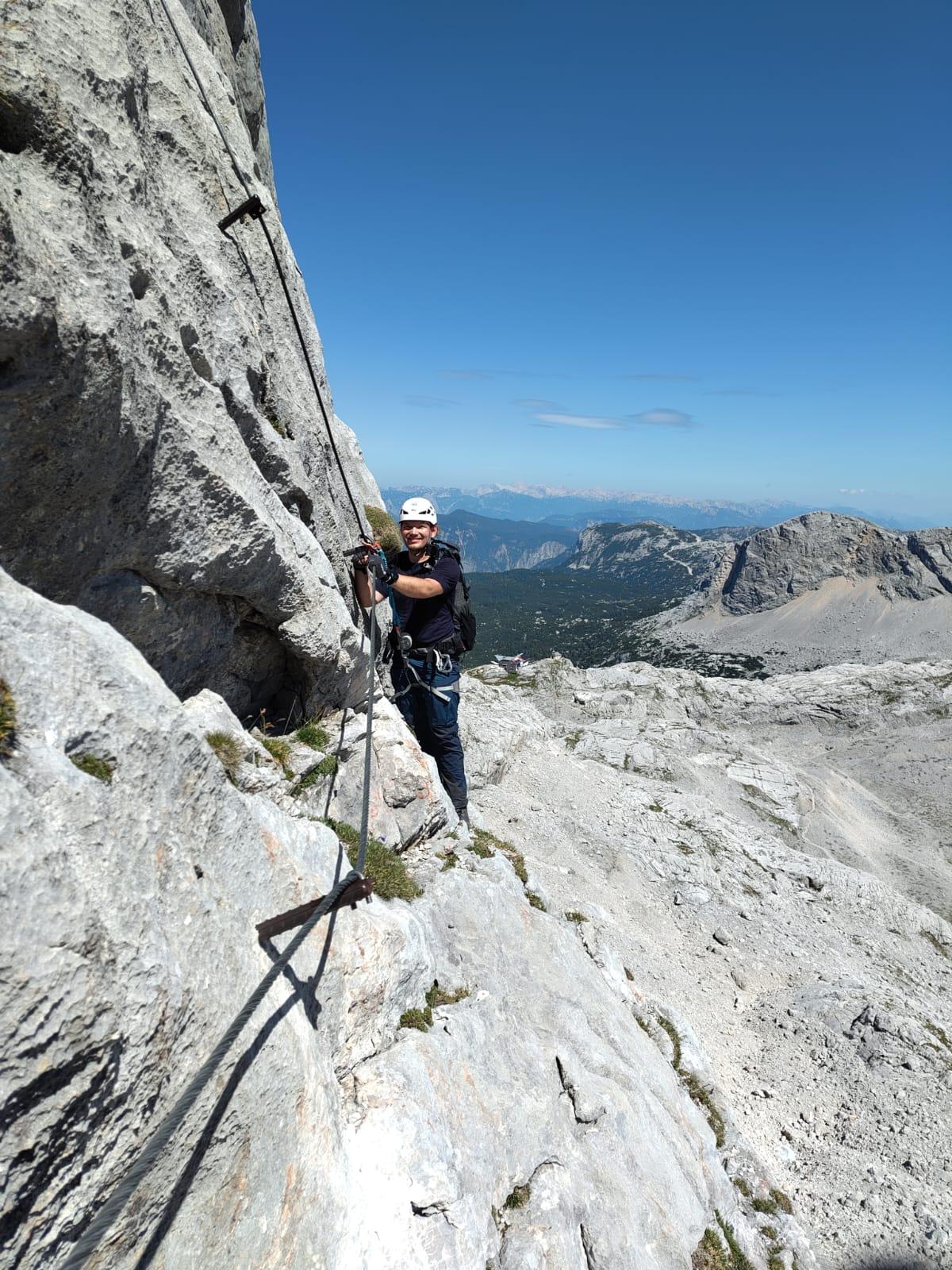
Schreibe einen Kommentar